With our 6am alarm, we woke up to beautiful views of the Mediterranean Sea from our balcony on Hadera Beach. Breakfast was at the hotel buffet, and I was able to see my friend Greg Tidwell from Ohio and we agreed to meet up later in the trip for dinner to catch up.
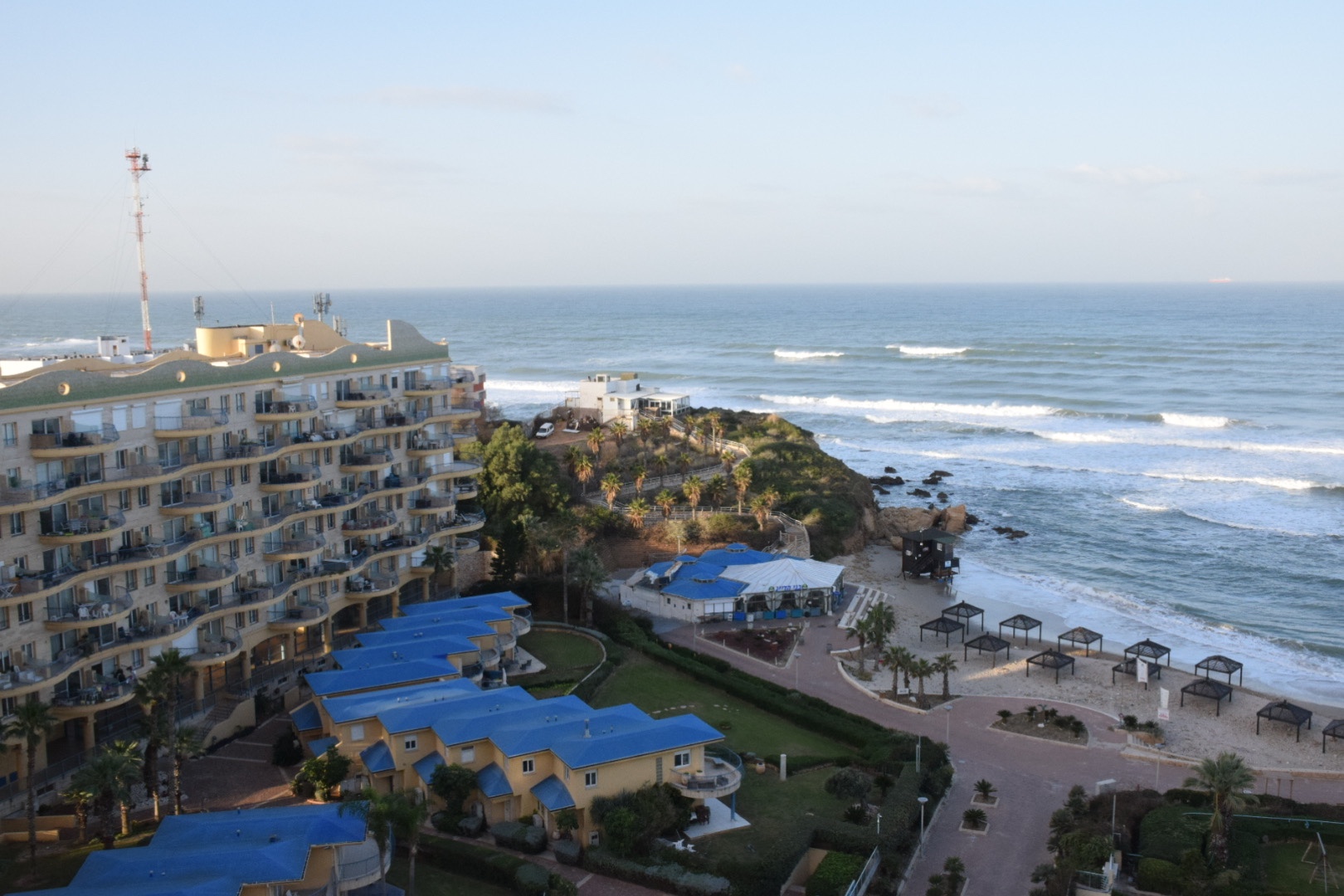
After breakfast, I went down to the beach to get some photos and found a lot of cats roaming around. This continued to be a trend throughout the day, and later I asked our guide about all the cats. He explained that Israelis love cats, thinking that they clean up the area by killing rats and other rodents. Because of this they feed them and try to keep them close by. It kind of reminded me of seeing all the chickens in Hawaii, but I never expected to see cats in Israel.
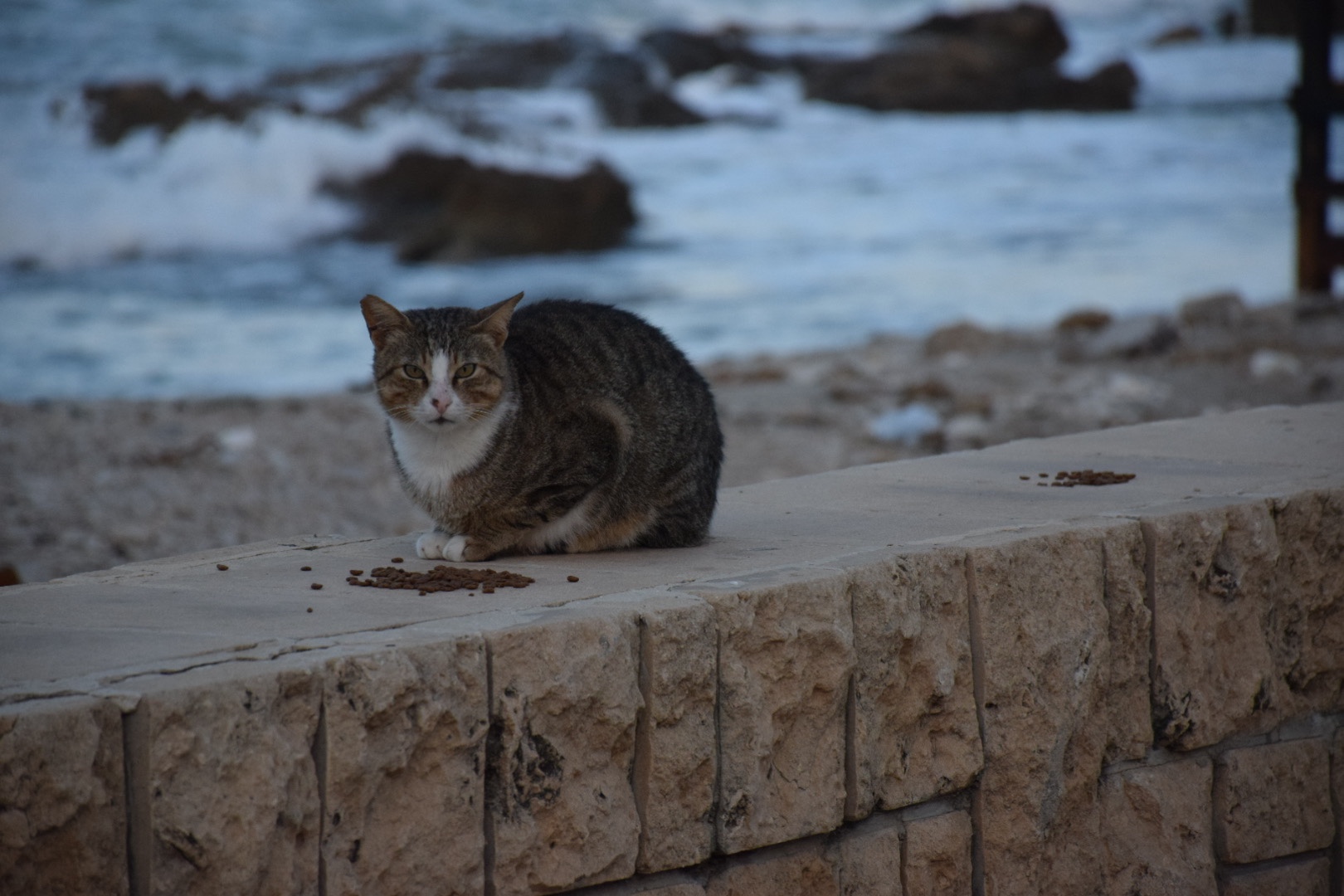
While I was on the beach, I wanted to get a picture with my foot touching the edge of the Mediterranean as it came up on the shore. I ended up getting my picture but also accidentally submerged both of my feet in the process. Not an ideal way to start the day.
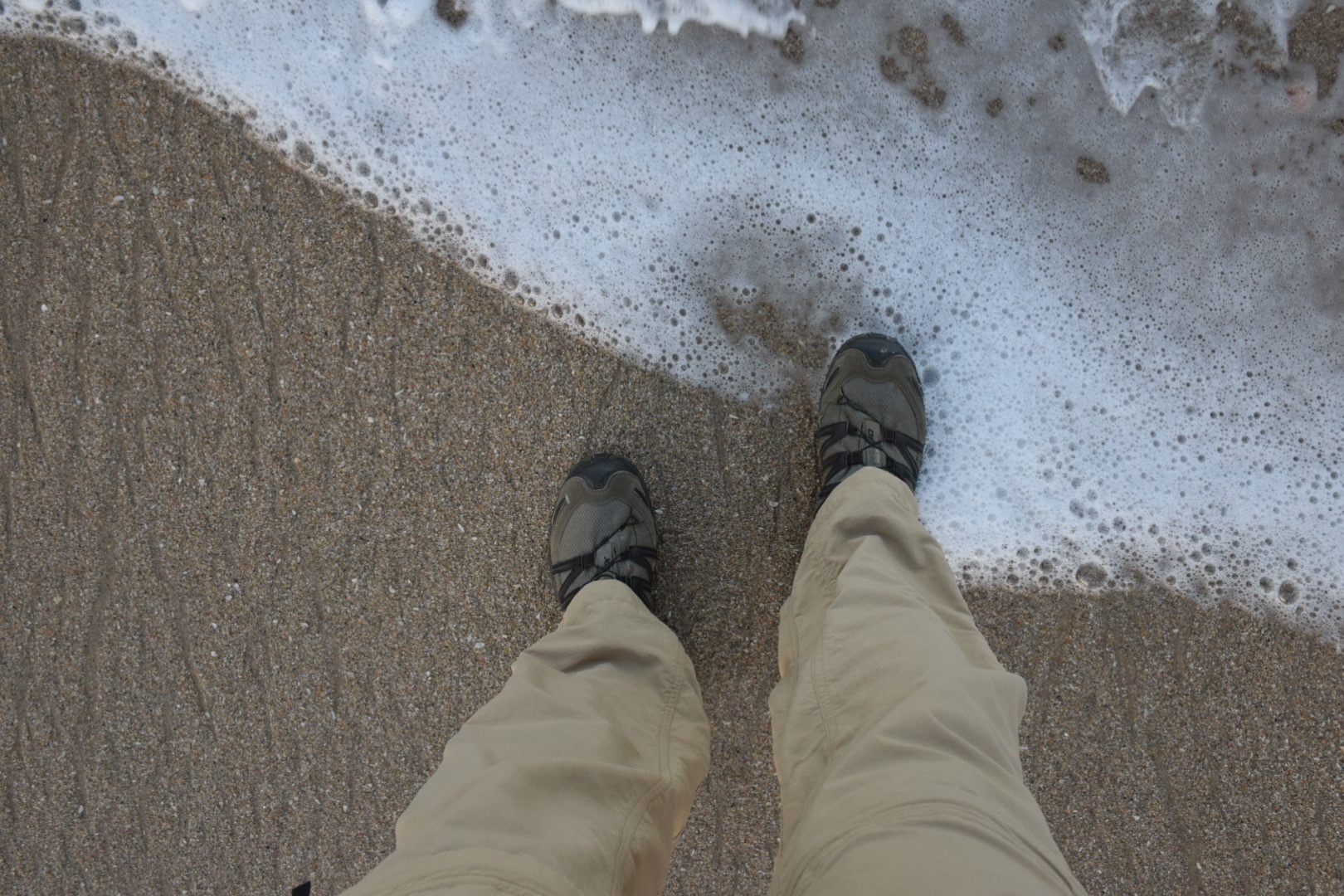
We boarded our busses around 7:45am, and our big group was split into two busses with two different guides. We were on the bus with Dr. Cloud and our guide Murad. Murad is an Arab Christian with a bachelors degree in Natural Archeology and a masters in Biblical Christianity. He explained that “Murad” is his Arabic name, and it means “Inspiration.” Since he is a Christian, he also has a Christian name, which is “George.” He said that he never goes by George because no one knows him by that name. Our first stop this morning was Caesarea Maritima (“By the Sea”), which was about 40 minutes north on the Mediterranean.
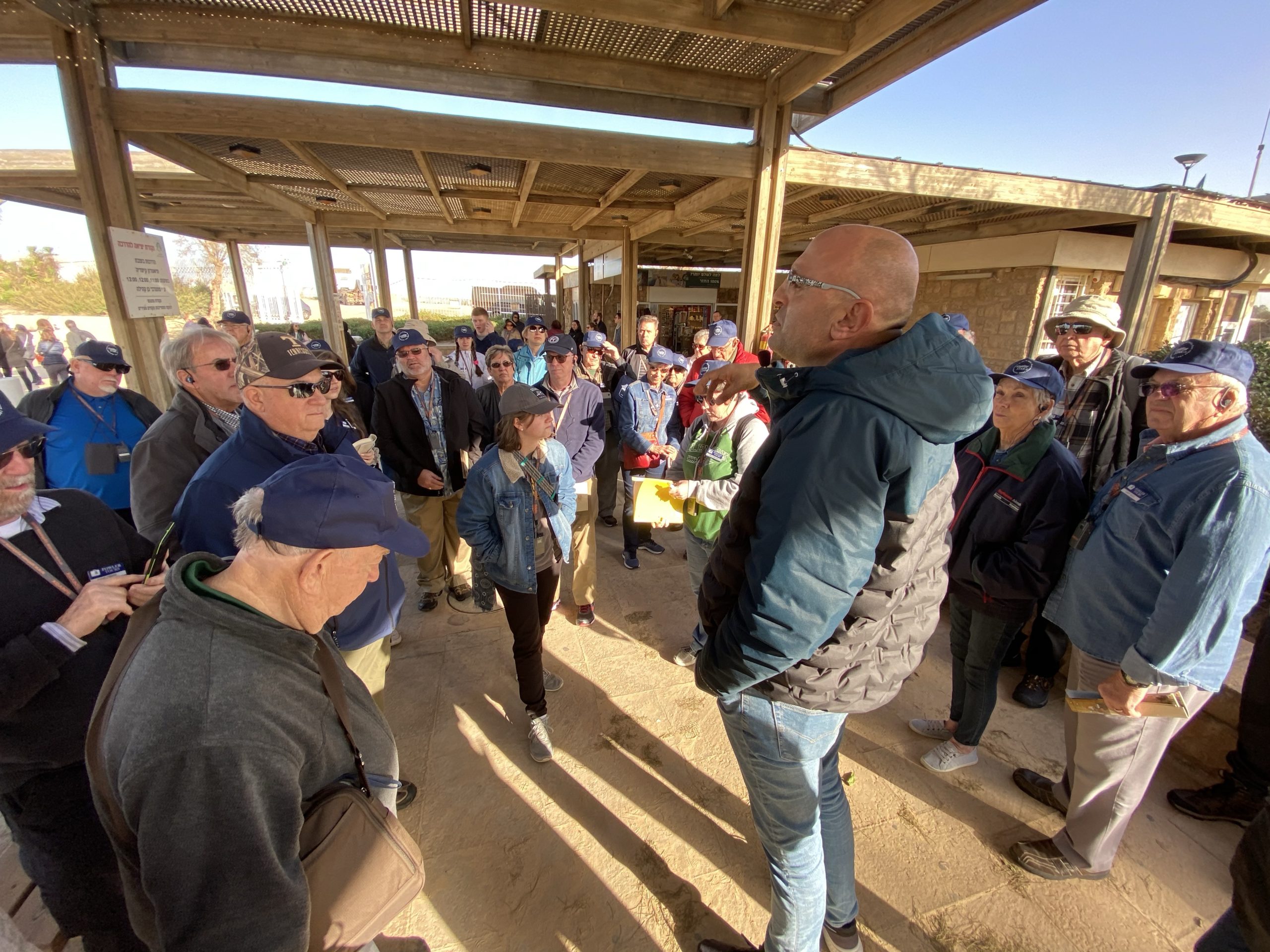
Shortly after we departed, Dr. Cloud led us in a prayer, and then Murad started to tell us about his belief in Jesus. He said that he doesn’t need to make up beautiful stories as a guide, because the facts about these lands and about Jesus are enough to have faith. He assured us that visiting the sites on our pilgrimage would strengthen our faith, and the best guide to the Holy Lands is the Bible. He later explained that Christians make up only 250,000 of the 12.5 million people in Israel.
He talked to us about the writings of Flavious Josephus, who was a Jew that wrote about the history Jews for the Romans. Murad said that he believed the writings of Josephus to be the most important historical accounts outside of the Bible. He talked about the different opinions regarding the accuracy of Josephus, and that he accepts Josephus as truthful. Murad used this as a jumping off point for talking to us about the political and religious climate of the time of Jesus. He talked to us about the fact that Palestine was under Roman rule at that time. He also talked about how Josephus had explained that during this time there were three primary groups of Jews; the Pharisees, Sadducees, and Essenes. The Jews were looking for a Messiah (“anointed one”) who would be a political leader that would deliver them from Roman rule.
At this point he stopped and said that we looked too serious, so he told us a joke. He said that in Israel, in-laws are not liked very much, and that Peter had denied Jesus three times because He had healed his mother in law (Mt 8:14-15, MK 1:29-31, Lk 4:38-41).
Caesarea Maritima
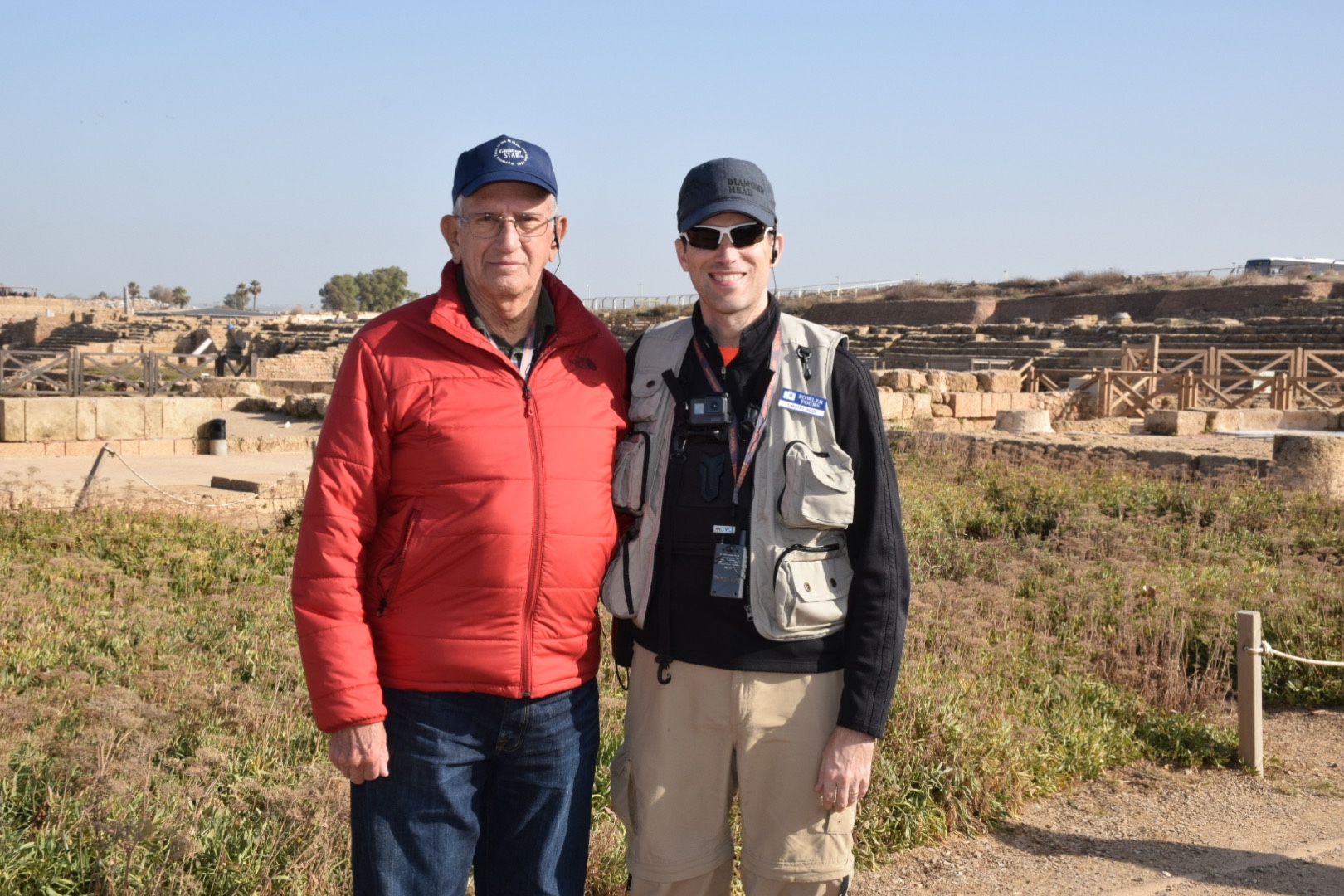
Our first stop was at the ruins of port city of Caesarea Maritima (known simply as “Caesarea” in Biblical times). “Maritima” literally means “by the sea” as this city was on the Mediterranean. Some Biblical highlights of Caesarea:
*The city only appears in the book of Acts (Acts 8:40; 9:30; 10:1, 24; 11:11; 12:19; 18:22; 21:8, 16; 23:23, 33; 25:1, 4, 6, 13).
*It is first mentioned when Philip came to Caesarea as he went from city to city, spreading the gospel after the conversion of the Ethiopian eunuch (Acts 8:40).
*After Paul’s conversion, Paul was brought to Caesarea and sent on a ship to Tarsus to avoid death by those who were opposed to his testimony (Acts 9:30).
*Caesarea was the home of Cornelius, and was mentioned in Acts 10:1, 24 and 11:1 related to his conversion by Peter who was called from Joppa.
*Soon after Peter escaped from prison, Herod Agrippa I journeyed to Caesarea where he made his final speech (Acts 12:19–23). Acts records that he sat down and praised himself as one with the voice of a god (Acts 12:22). An angel of the Lord struck him down (with worms) because he did not give God the glory (Acts 12:23).
*During Paul’s second missionary journey, it is recorded that after he landed at Caesarea, he greeted the church (Acts 18:22).
*During his third missionary journey, Paul visits Philip the evangelist, who had a house in Caesarea (Acts 21:8).
*The last mention of Caesarea in the New Testament comes in the long narrative of chapters 23 through 26, in which Paul appears before Felix, Festus, and Agrippa II (Acts 23:33–26:32). Paul makes his case before Festus, finally invoking his right as a Roman citizen and appealing to Caesar (Acts 25:11).
While at Caesarea, we were able to see the ruins of the theater and palace that were built by Herod the Great between 22 and 10 B.C. The city was named for Caesar Augustus. Murad said that this Herod was considered “great” not because he was a great man, but because he was a great builder.
Murad explained that these ruins are very important because they show us what a Roman city looked like at that time. It was built according to a “Hippodamian Plan” which consisted of horizontal and vertical roads creating square-shaped patterns that contained buildings. It shows that Romans planned out their cities in detail before starting to build. This style was invented by the architect Hippodamus of Miletus. Caesarea was also full of sculptures, as was typical of Roman cities of the time.
The palace at Caesarea was likely used by Pontius Pilate while he was a Roman Governor before moving to Jerusalem. An inscription mentioning him was found in Caesarea, and there is a replica of this inscription on the palace site today (the original is in a museum). The synagogue at Caesarea was also where the Jewish revolt against the Romans began in 67 A.D.
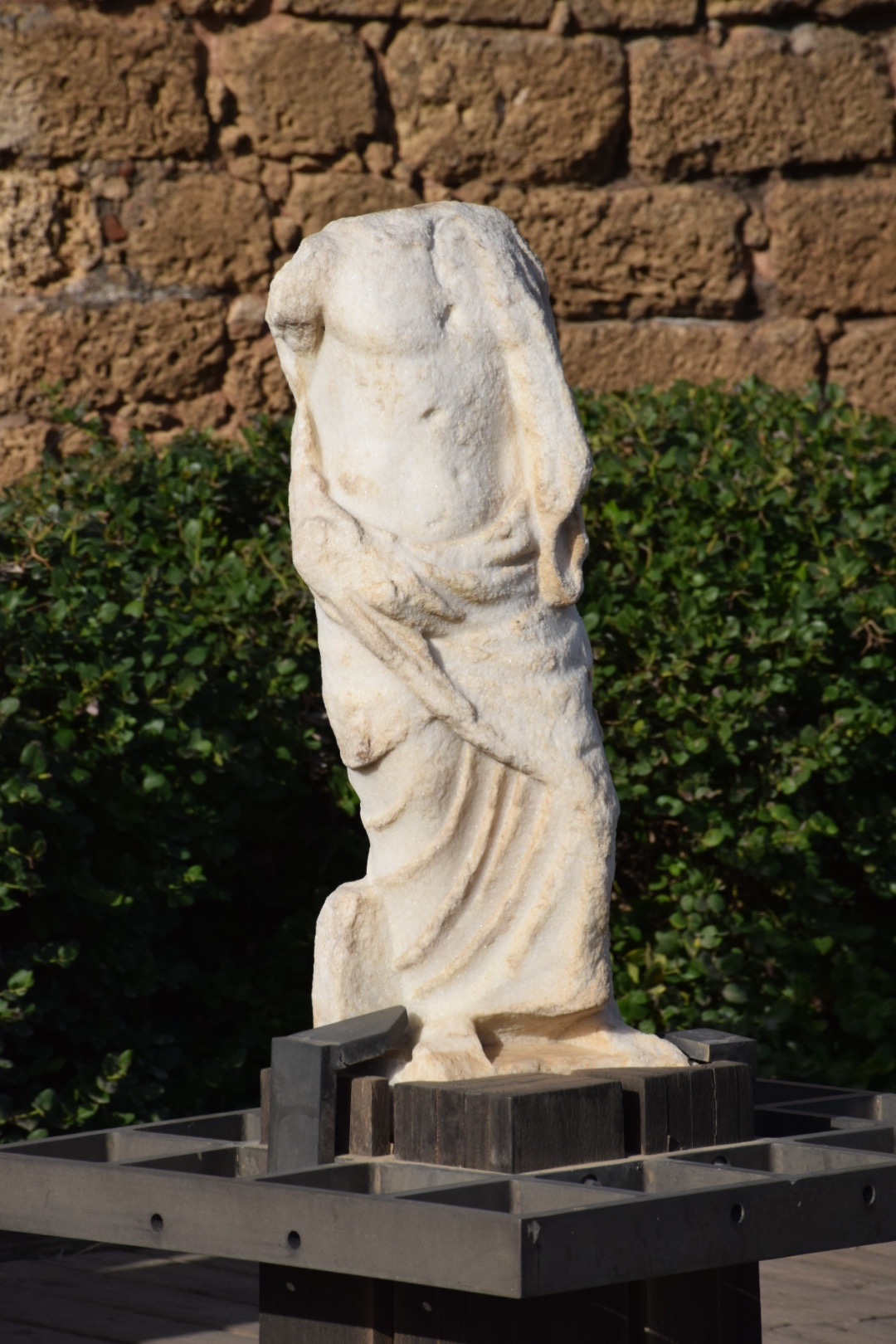
We started our tour by looking at some of the sculptures which have been found in Caesarea that are now located right outside the theater. All of them are headless as they were beheaded because Islam does not allow icons.
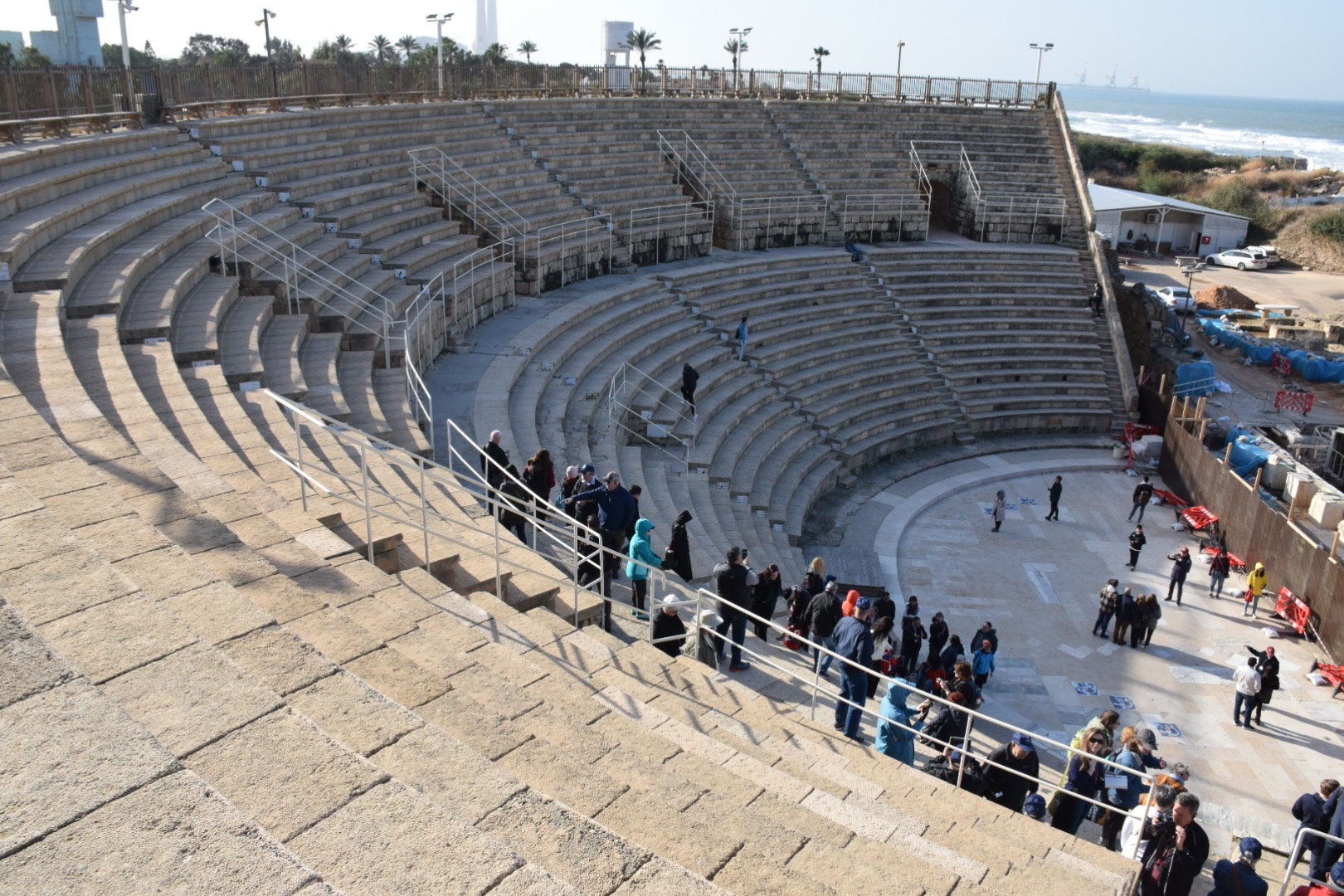
We next visited the theater of Caesarea, which is a half-circle (Murad explained that a full circle would be an amphitheater). Most of what is visible is original, but the seats have been restored. While in the theater, Jeff Hallums led us in a hymn while standing at the bottom and the rest of us sat in the seats of the theater. This was a very impressive structure.
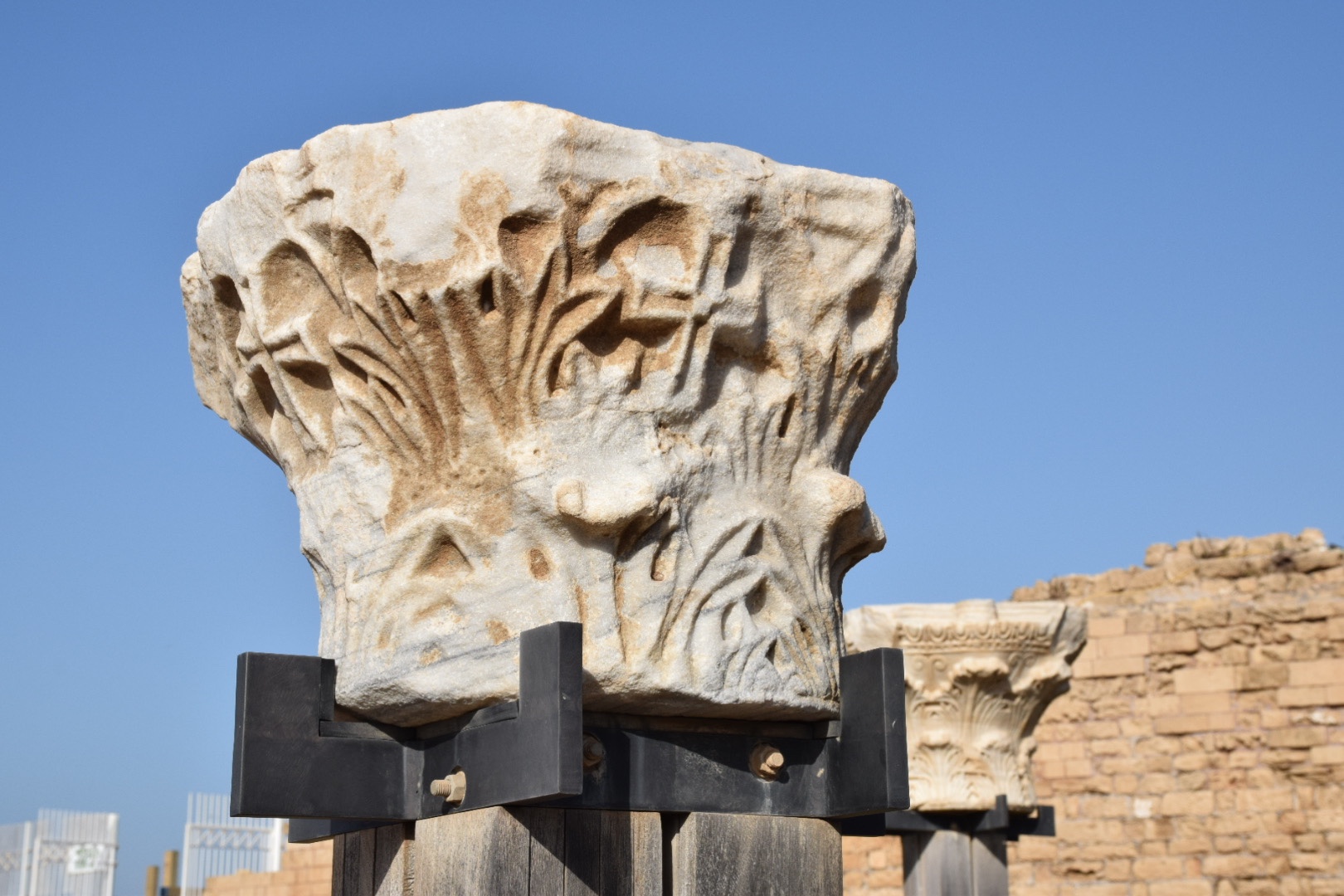
Next we were able to see some column fragments and a sarcophagus that have been uncovered at Caesarea. Murad explained to us about the different type of column architectures. He also explained that the marble and granite used in the construction of Caesarea were brought in from outside of Israel.
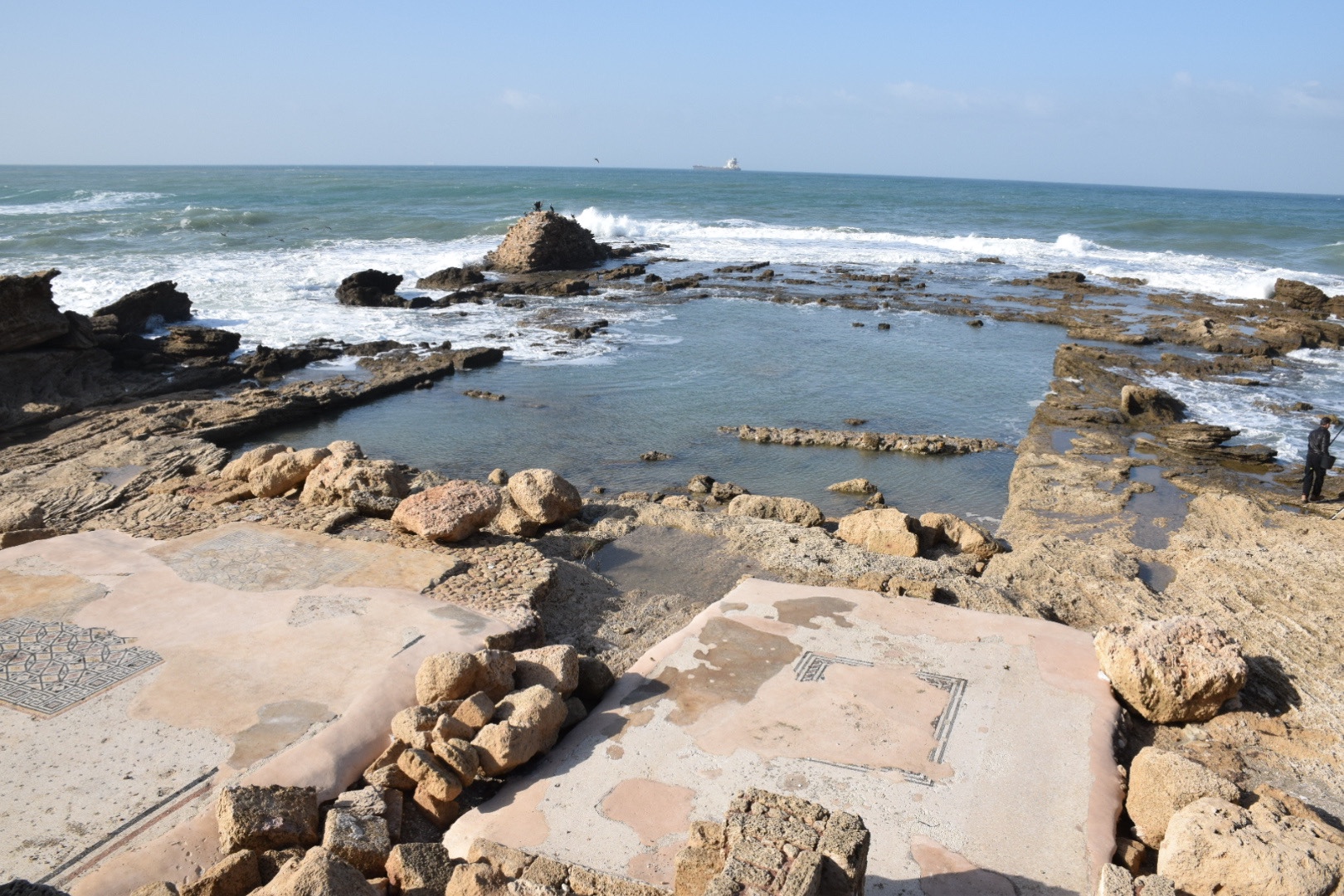
Our final stop was Herod’s palace, which included the ruins of the upper and lower levels, gardens, mosaics, a swimming pool, and the nearby hippodrome (this was built later). All of this was built right on the Mediterranean, and the views were stunning.
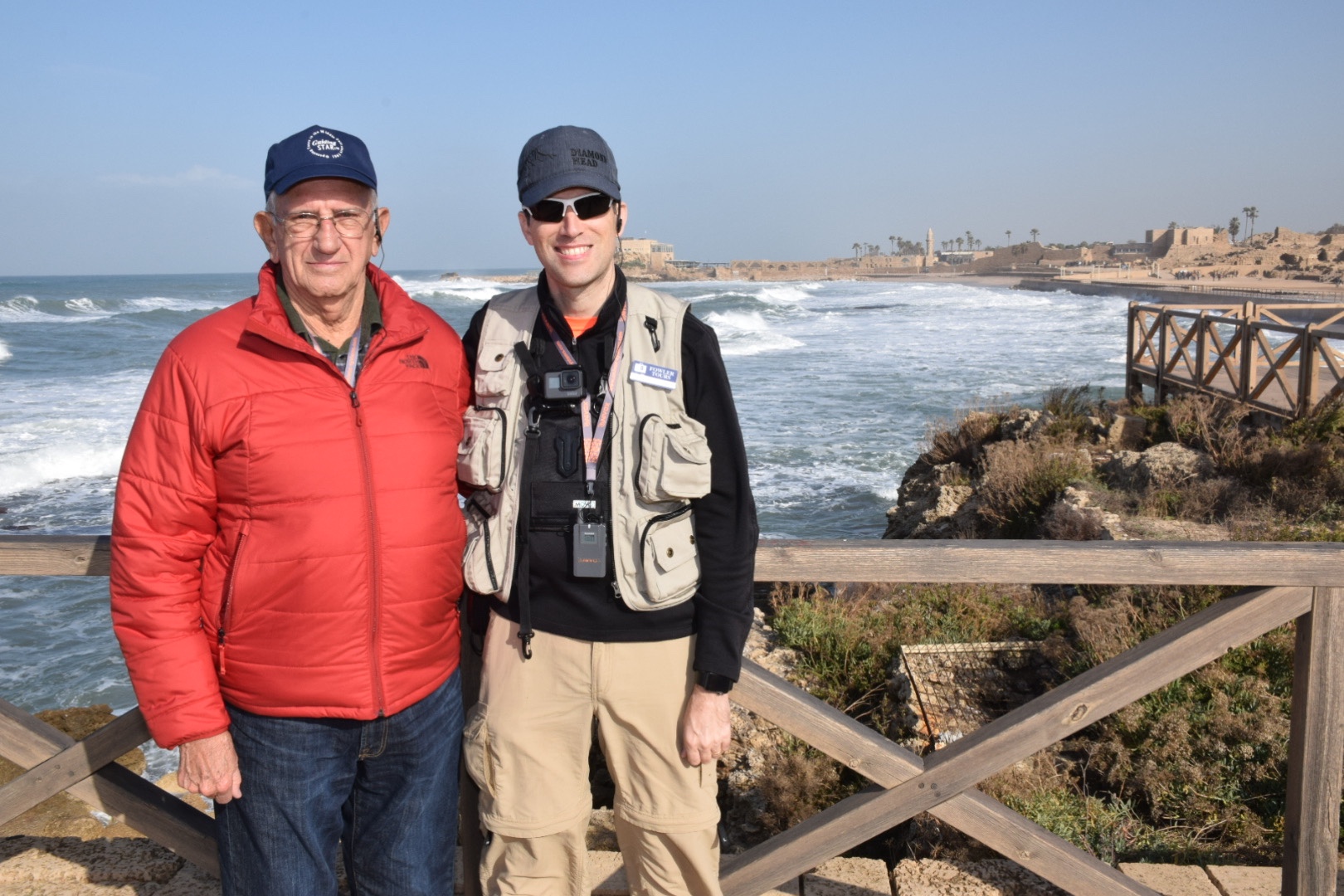
Murad also showed us the remains of a public toilet that are right outside the hippodrome. Hippodrome literally means “circle of horses” and was a full amphitheater for chariot races.
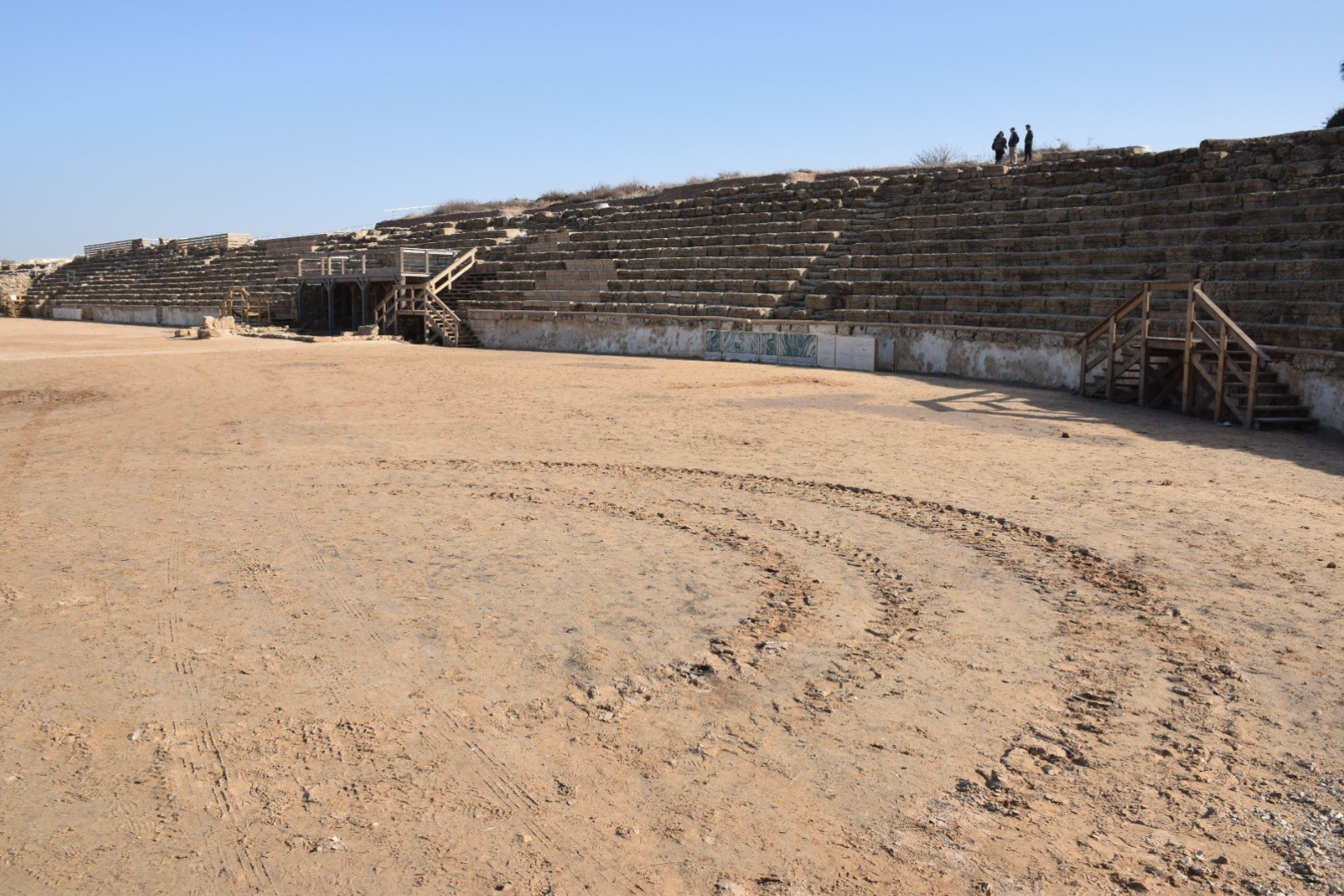
The Mediterranean side of the hippodrome is no longer there as it was consumed by the sea. Murad pointed out that all of the buildings in Caesarea were structures of amusement.
We boarded the bus for a 5-minute drive further north to see the remains of the ancient aqueduct at Caesarea. Aqueduct literally means “water carrier” in Latin.
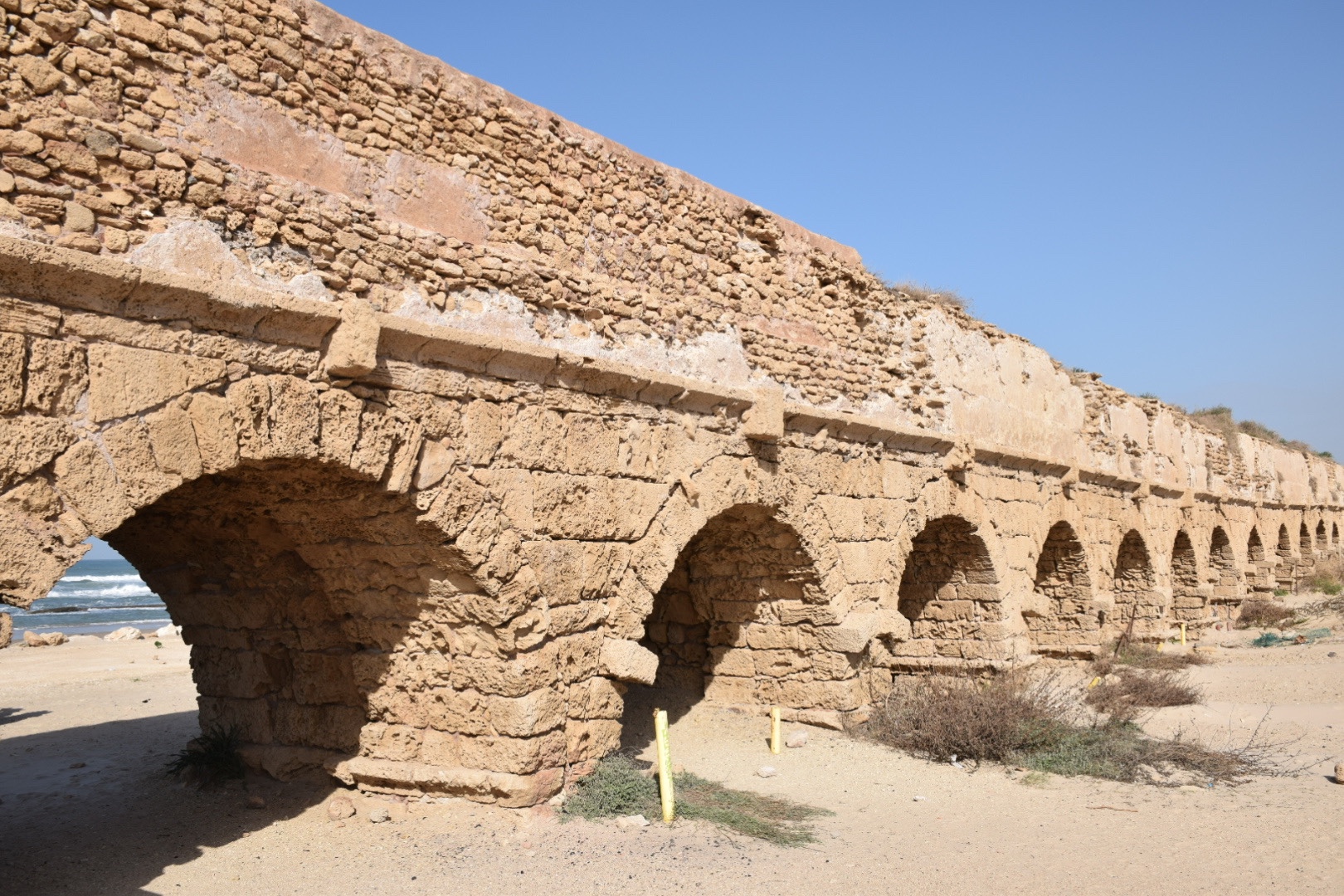
It was important for cities to have a source of fresh water, and this aqueduct was built by Herod the Great to carry water approximately 3 km from a spring on Mt. Carmel. This fresh water would have been used for daily consumption, ritual washings by the Jews, and fountains for the Romans.
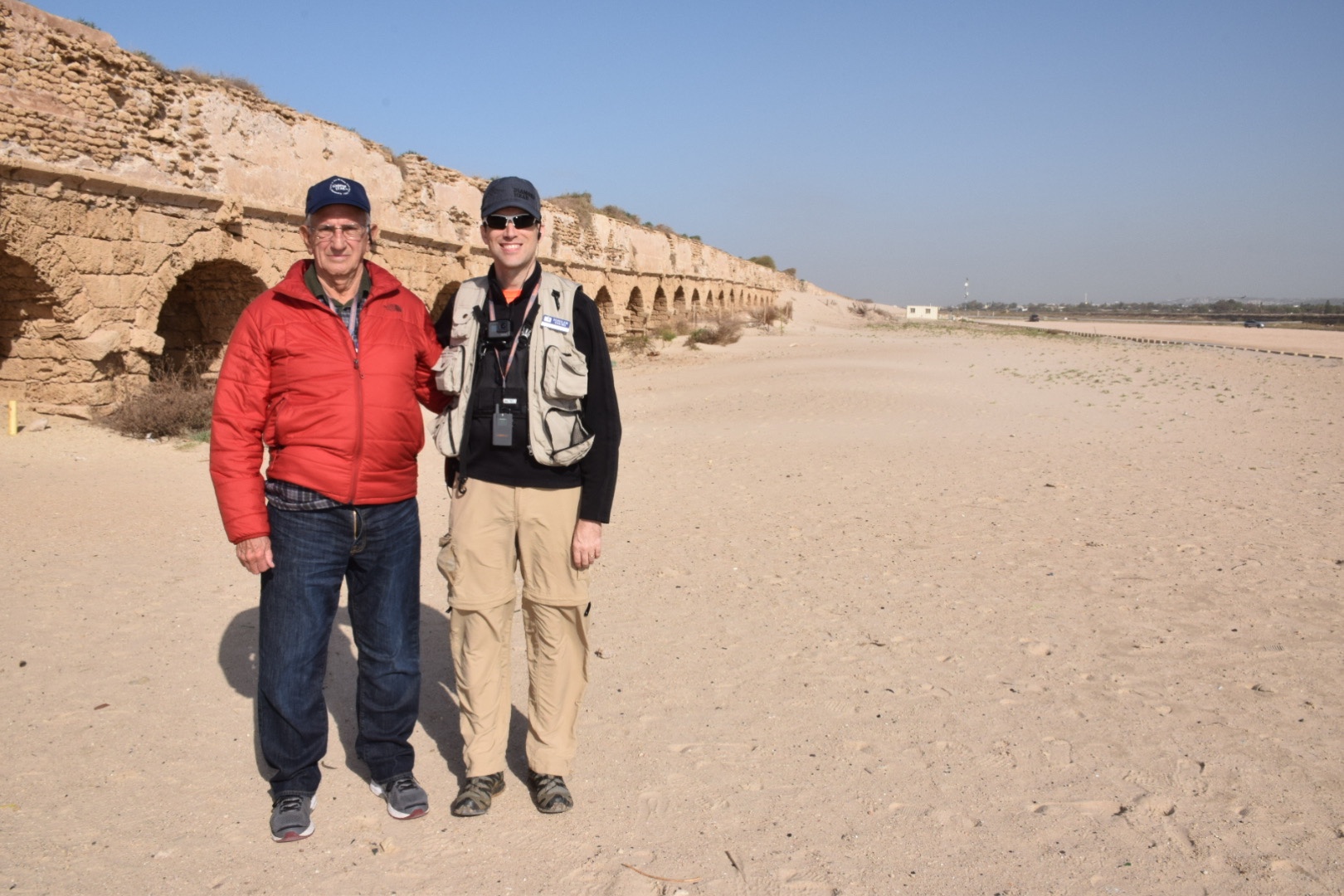
The aqueduct was composed of arches that supported a water canal. This is an impressive structure right on the beach of the Mediterranean.
My time spent studying the book of Acts is probably second only to my study of Romans so seeing Caesarea was very special to me. Overall it was definitely my favorite overall site of the first day.
Back on the bus, Murad explained that today the modern city of Caesarea is a very wealthy area with houses costing 2 to 3 million dollars each. He also used this time to explain to about the different geographical and temperate regions in Israel. This would allow someone to swim in the Dead Sea during the winter and ski on Mt. Herman.
Jezreel Valley
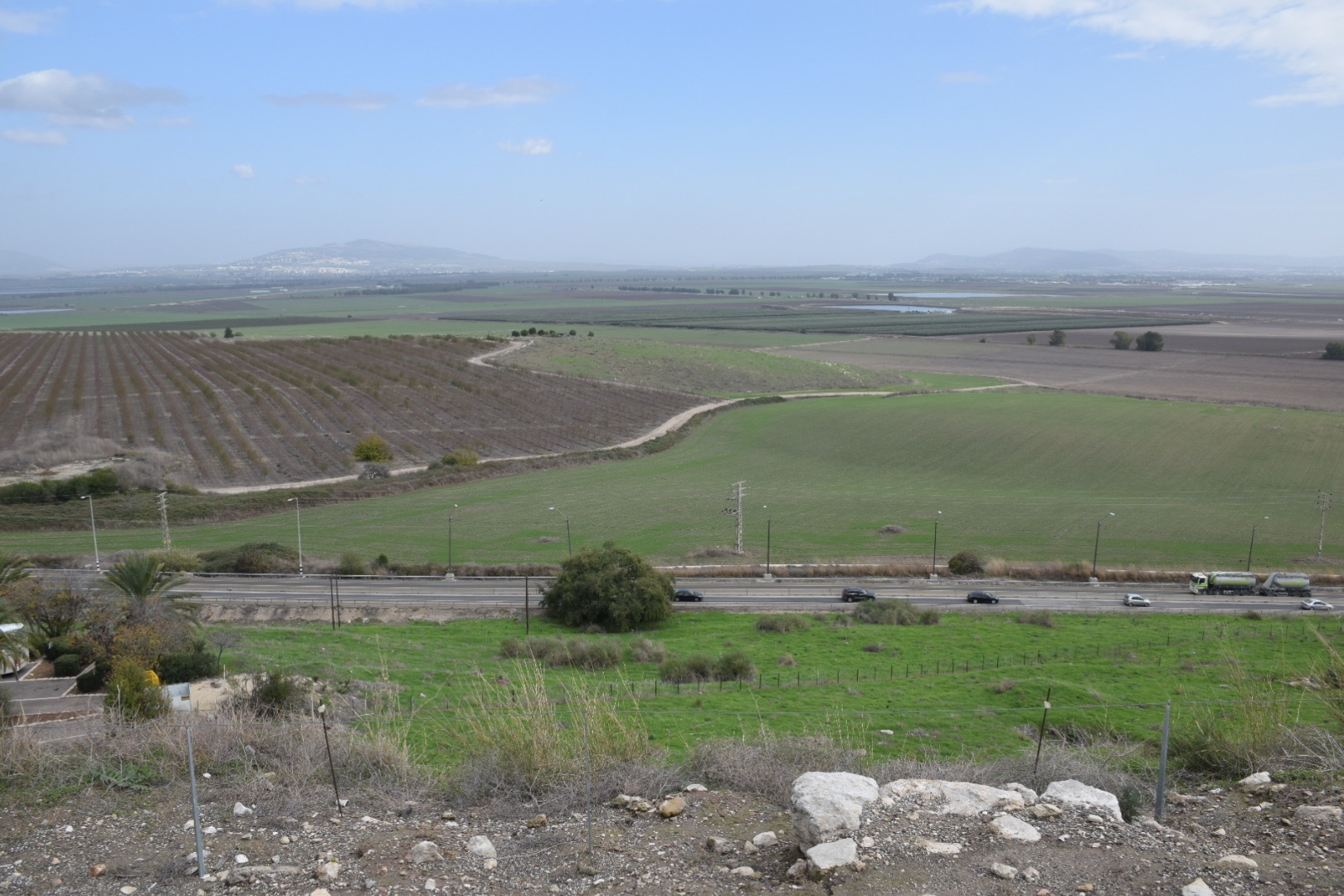
From Caesarea, we headed northeast and spent most of the rest of the day at two sites in the Jezreel Valley. This valley is south of Galilee and north of the hill country of Ephraim. Today it appeared very green and lush, and we got some great views of it from both of our stops.
Some of the significant biblical events that occurred in this valley include:
*Deborah and Barak defeated the Canaanites in the Jezreel Valley (Judg 4–5).
*Gideon fought and defeated the Midianites on a hill in this valley with just 300 men (Judg 6–7).
*Saul camped at the spring of Jezreel before his final battle with the Philistines and his death on Mount Gilboa (1 Sam 31).
Megiddo (Tel Megiddo)
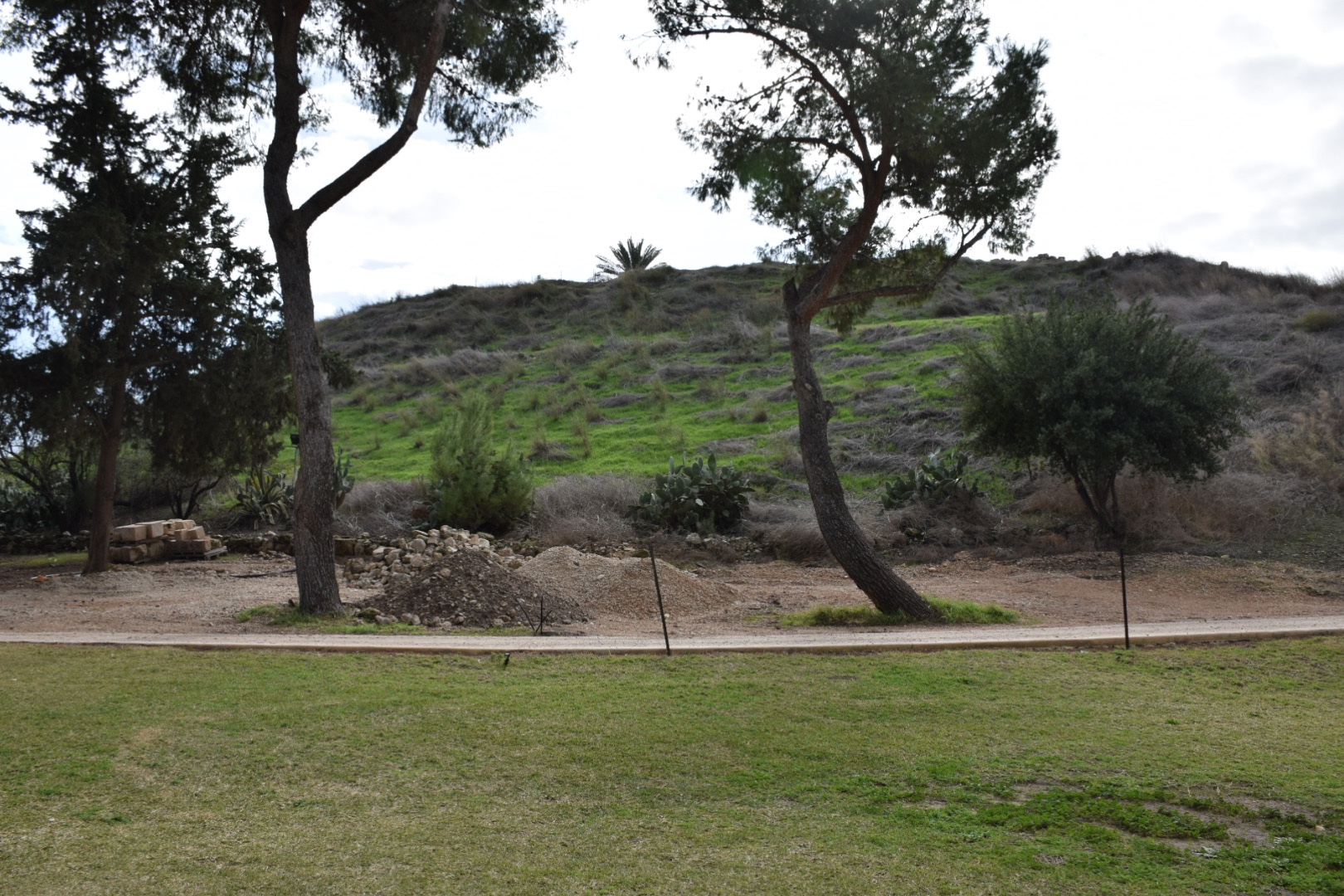
Our first stop in the Jezreel Valley was at Tel Megiddo. This was approximately a 45-minute drive from Caesarea. Murad explained to us that the word “Tel” literally means an artificial hill crated by cities built one on top of the other. When a city was destroyed by earthquake or war, and a new city was built on top, this created layers or strata. Different strata can be from different eras or time-periods such as below:
Strata
Layer 3: Islamic – Top / Newest
Layer 2: Byzantine – Middle
Layer 1: Roman – Bottom / Oldest
Megiddo is a fortress city that dates back to about 5,000 B.C., located on the southwest side of the Jezreel Valley at the foot of Mount Carmel. Megiddo was a city that was located on the Via Maris road, which was one of the three most important roads at the time of Jesus. The Via Maris originated in Egypt and went all the way to Mesopotamia. Megiddo’s location on this route showed that the city was very significant. This is also evidenced by the words of Pharaoh Thutmose III (15th century B.C.) of Egypt, “… for the capturing of Megiddo is the capturing of a thousand cities.”
Megiddo is referenced 12 times in the Old Testament. Megiddo is mentioned among the cities conquered by Joshua (Josh 12:21), though apparently they were unsuccessful at fully driving out the Canaanites (Josh 17:11). During the reign of Solomon, Megiddo was fortified along with Gezer and Hazor (1 Kgs 9:15). The city fell to Shishak (925 BC) and to Tiglath-pileser III in 733 BC. Josiah died at Megiddo in 609 BC in his confrontation with Pharaoh Neco (2 Kgs 23:29).
Upon arrival at Tel Megiddo, we watched a short movie and then began a walk / hike to the top of the Tel with Murad. We learned that Megiddo had been destroyed 30 times by waves of conquerors, and this has resulted in 30 levels or strata that comprise the Tel. According to tradition this will be the site of Armageddon as described in Revelation 16.
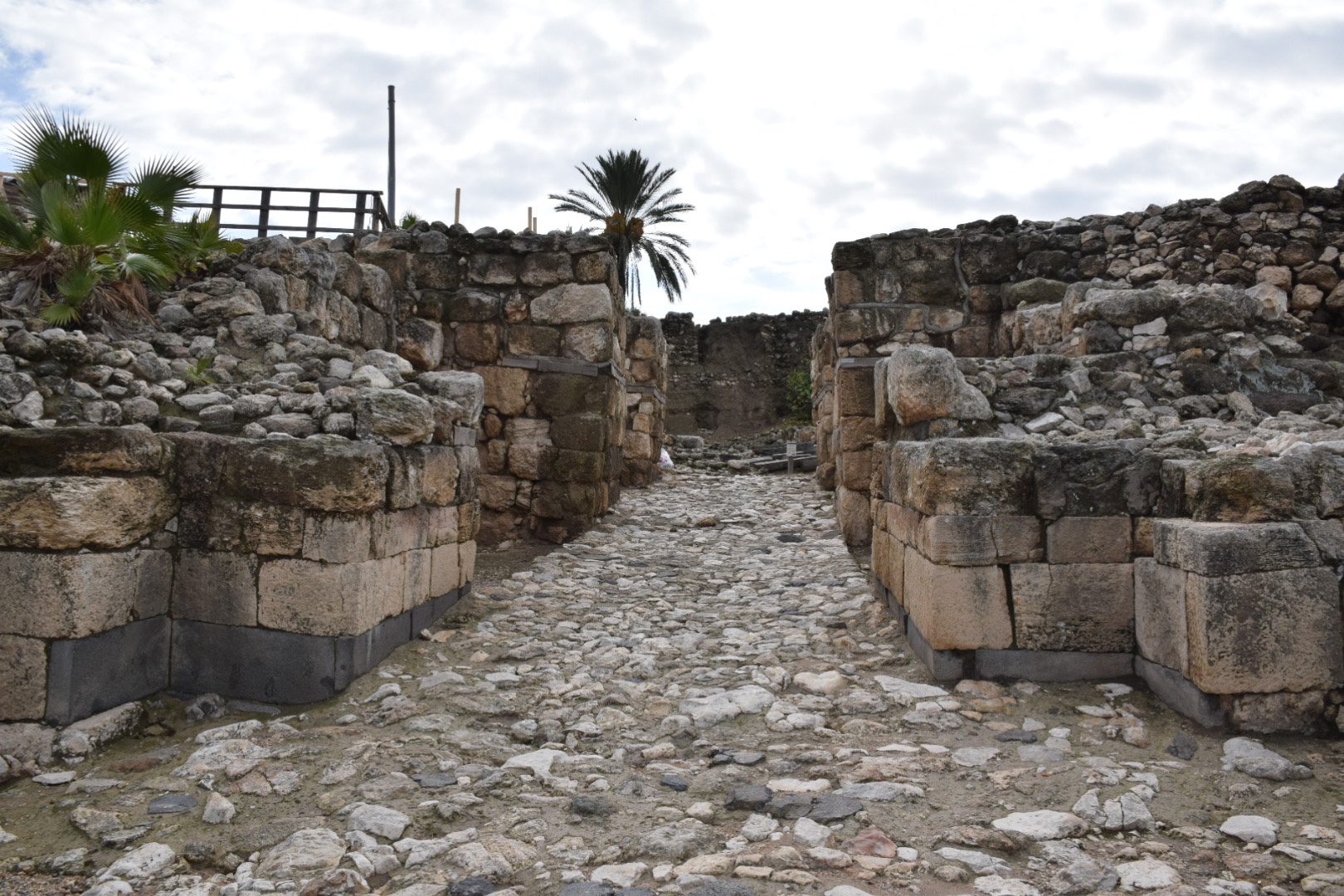
On the way up we saw the main gate to the city that dates from the 16th century B.C. (This means that it is 3500 years old). This was the only way in and out of city.
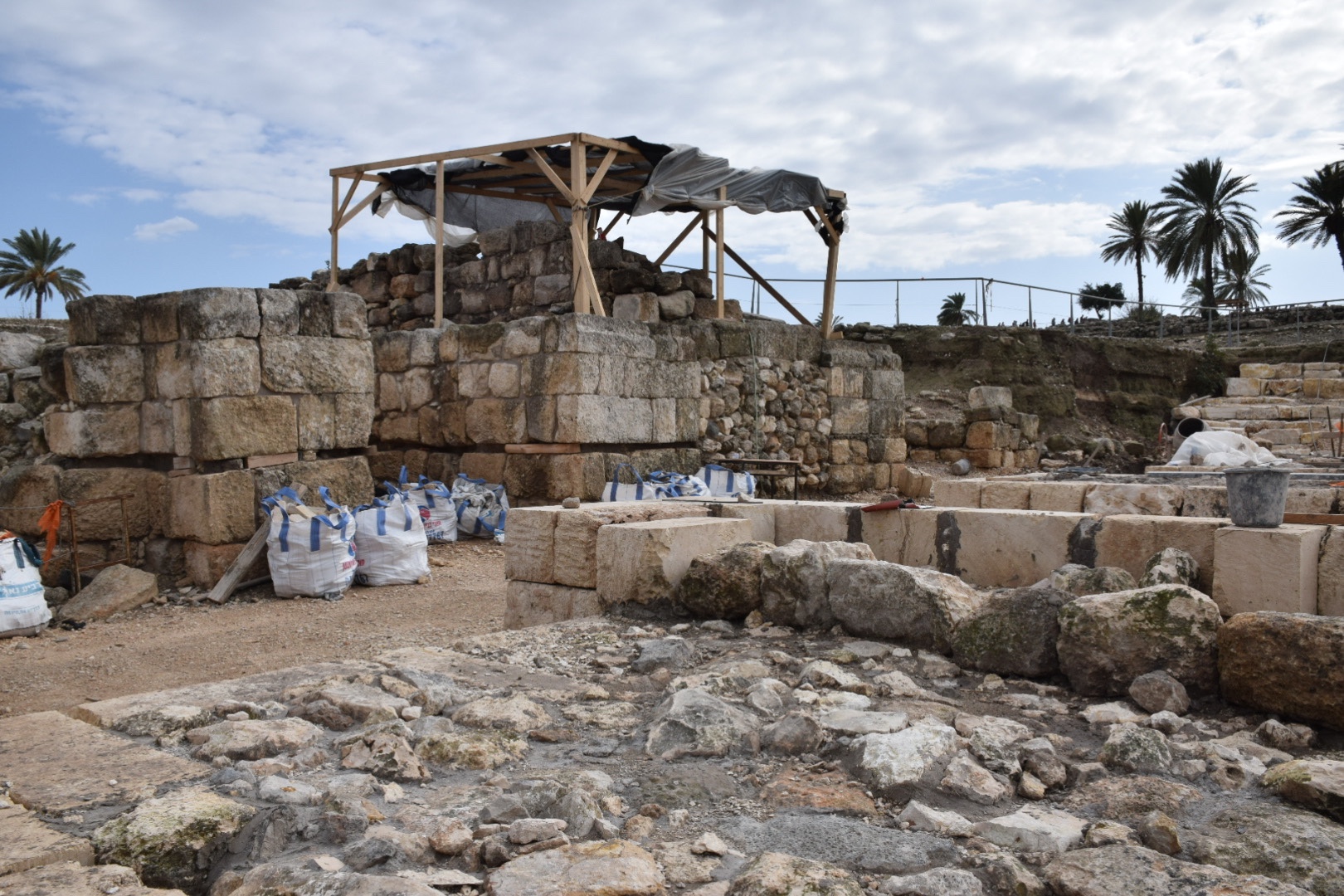
A little further up we saw another strata of gate from the 10th century BC. Murad explained that much of this gate has been destroyed due to archaeological digs to uncover the lower gate.
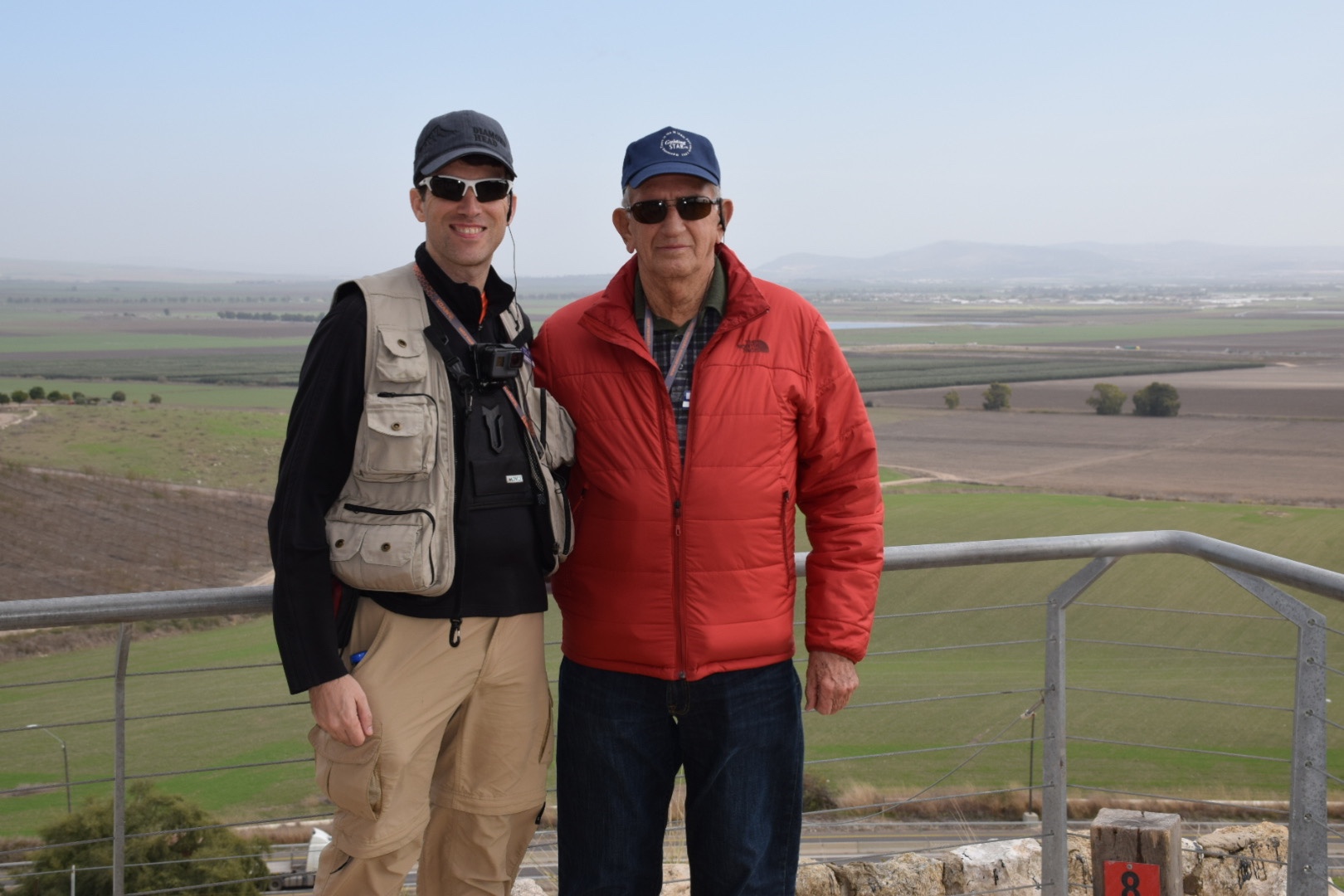
The views from the top of the Tel of the Jezreel Valley were stunning. We could see Nazareth and Mt. Tabor in the distance.
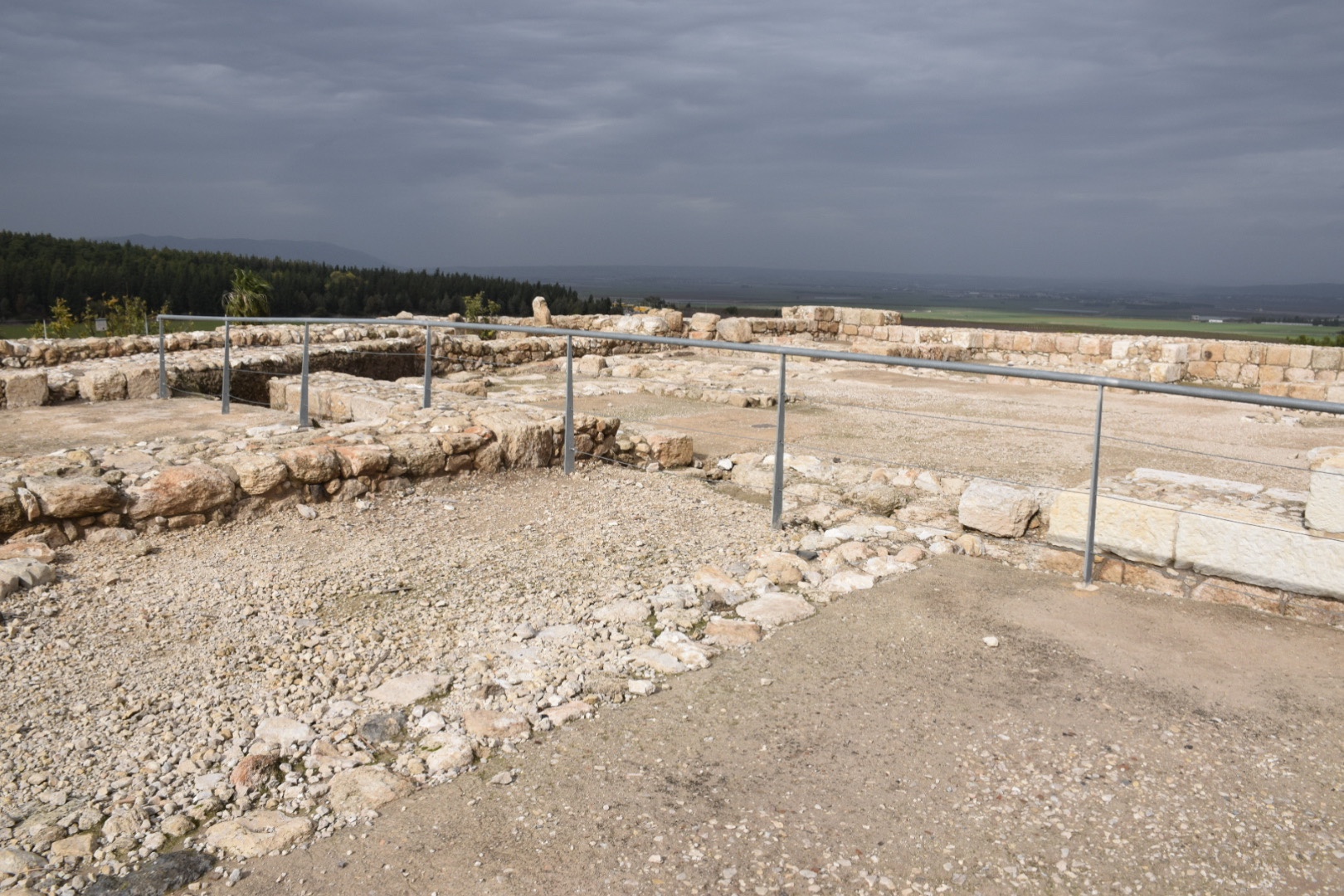
From there we were also able to see the ruins of a palace and stables. It is uncertain whether or not these structures were from the time of Solomon (10th century B.C.) or the time of Ahab (9th century B.C.). This is just incredible to think about.
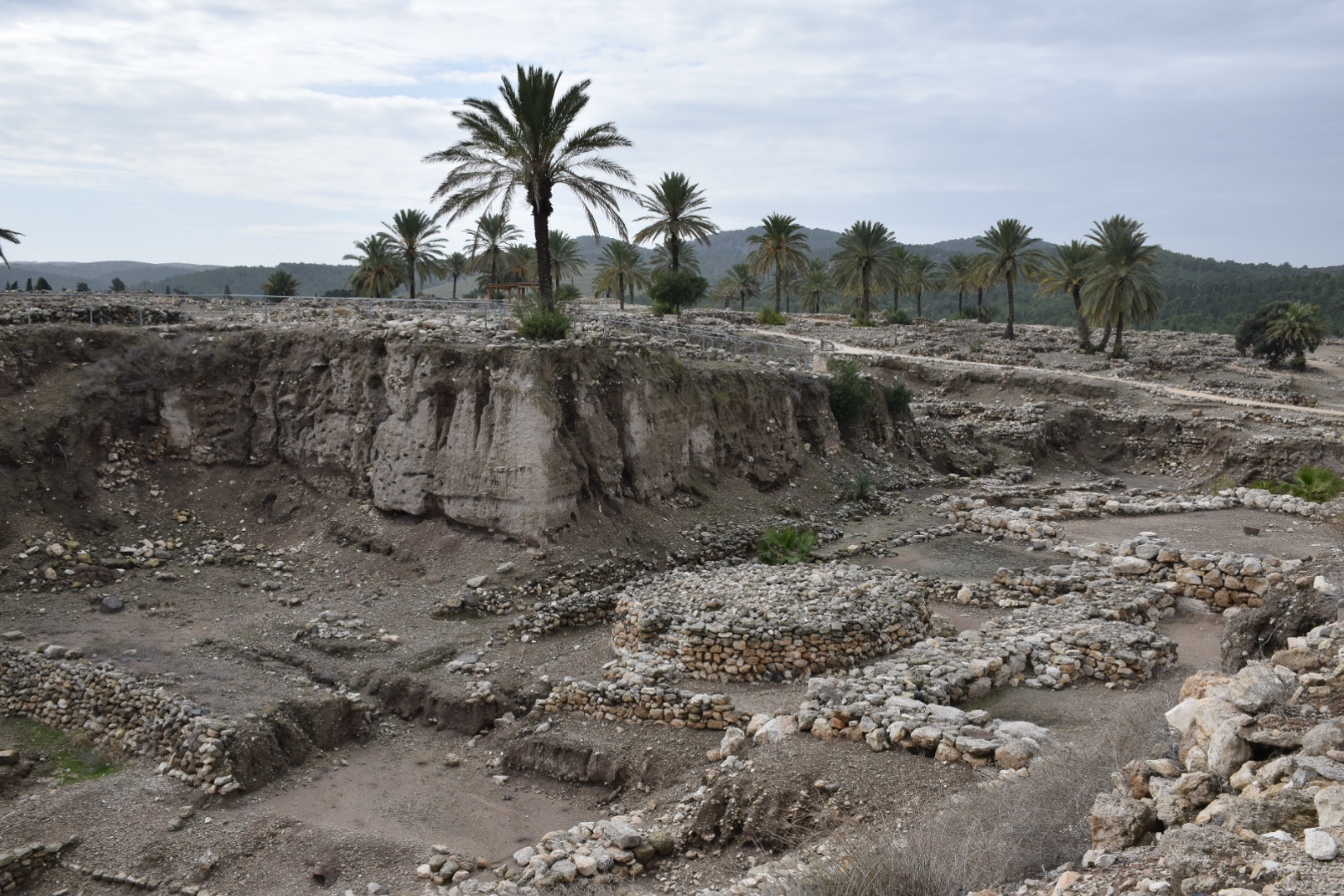
From here we could also really see the strata via some of the digs that have taken place.
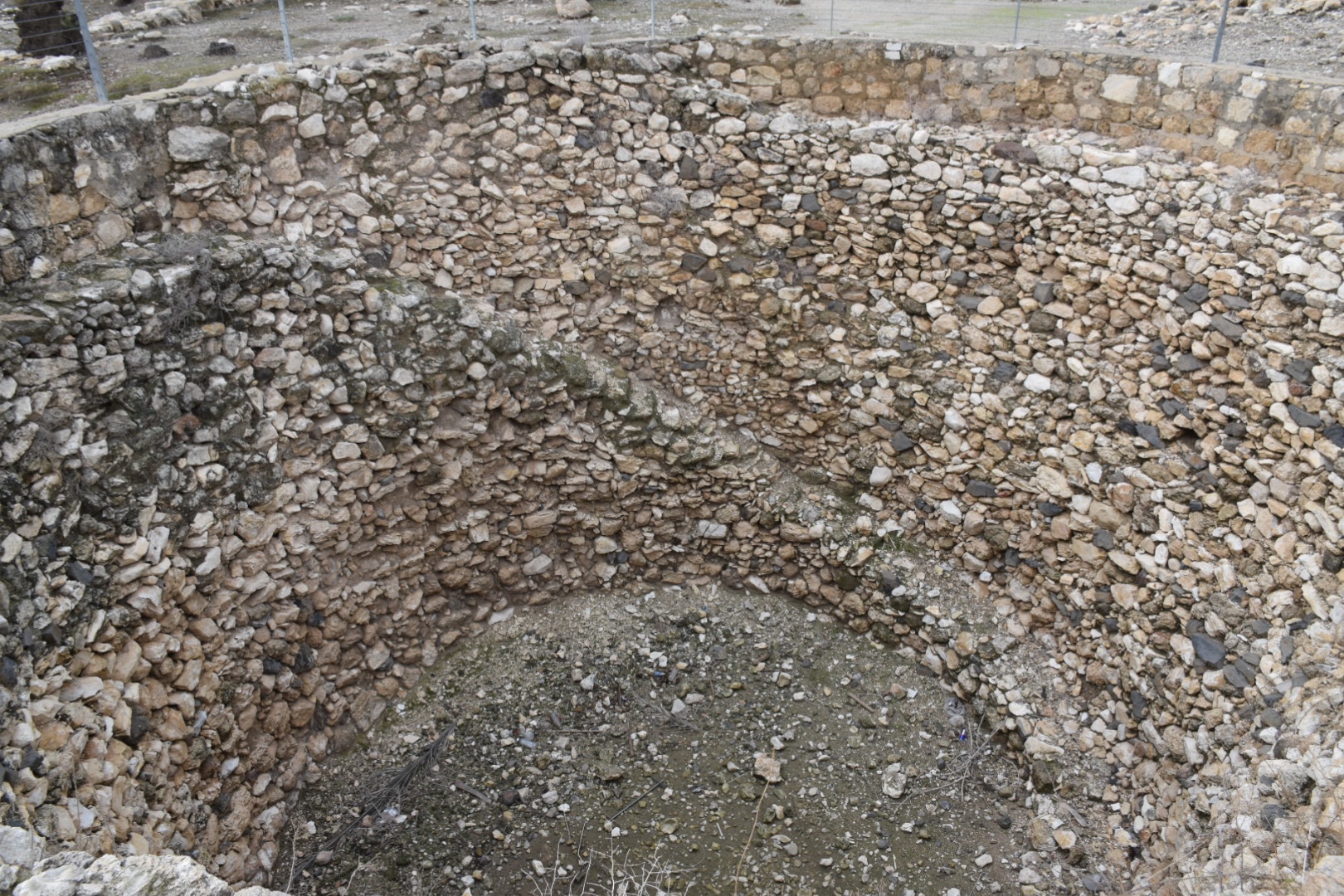
On the other side of the Tel, we saw a public grain silo down in the ground from the time of Jeroboam II (8th century BC – Northern Kingdom).
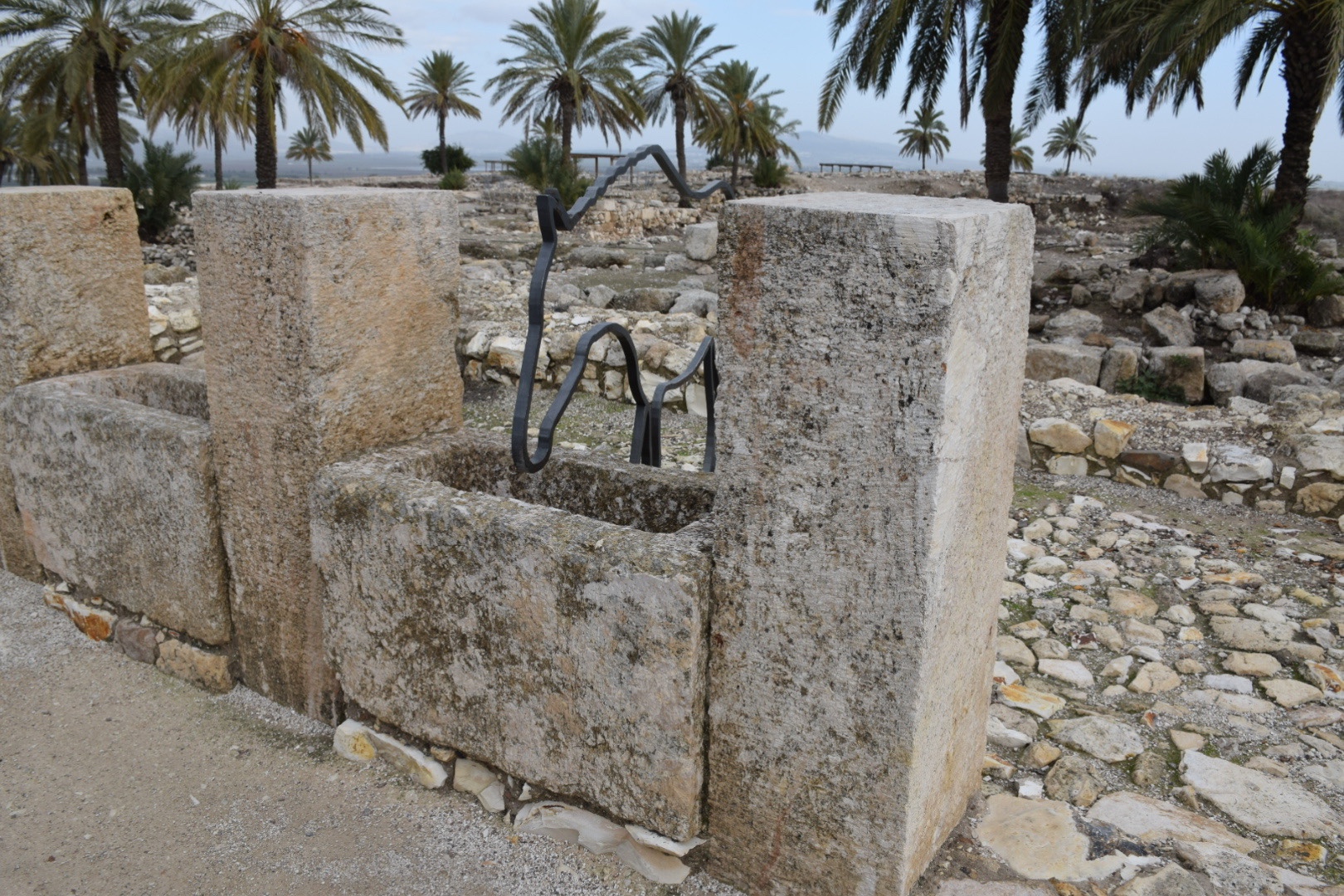
We also saw the remains of a stable from the 9th century BC.
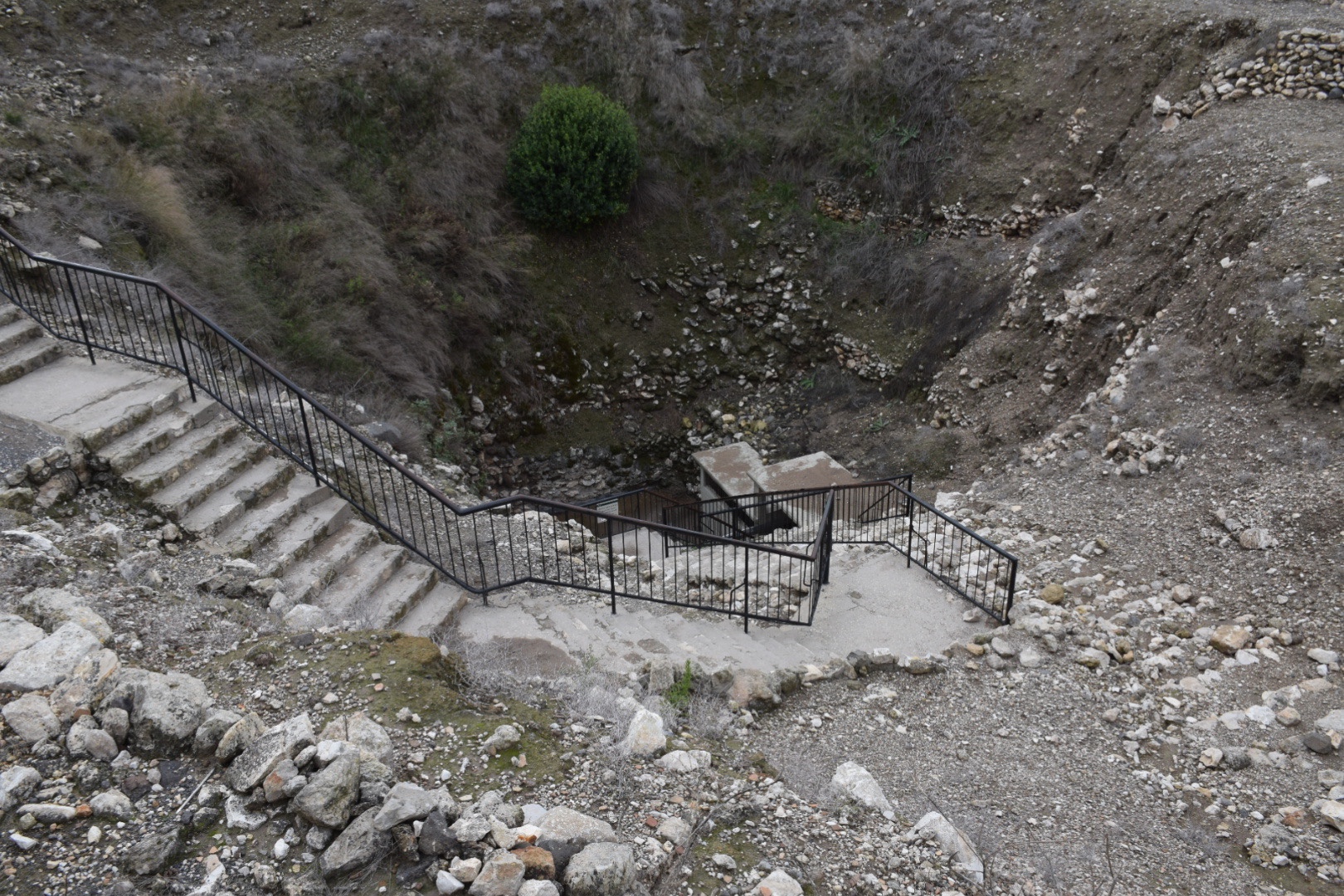
Our final stop at Megiddo was a water system that was built in the 9th century B.C. during the reign Ahab. The water system was a tunnel that was built underground to the spring which was the source of water for the city. This was key for being able to access the water supply during times of siege. The spring was covered from the outside so that it was only accessible via the tunnel.
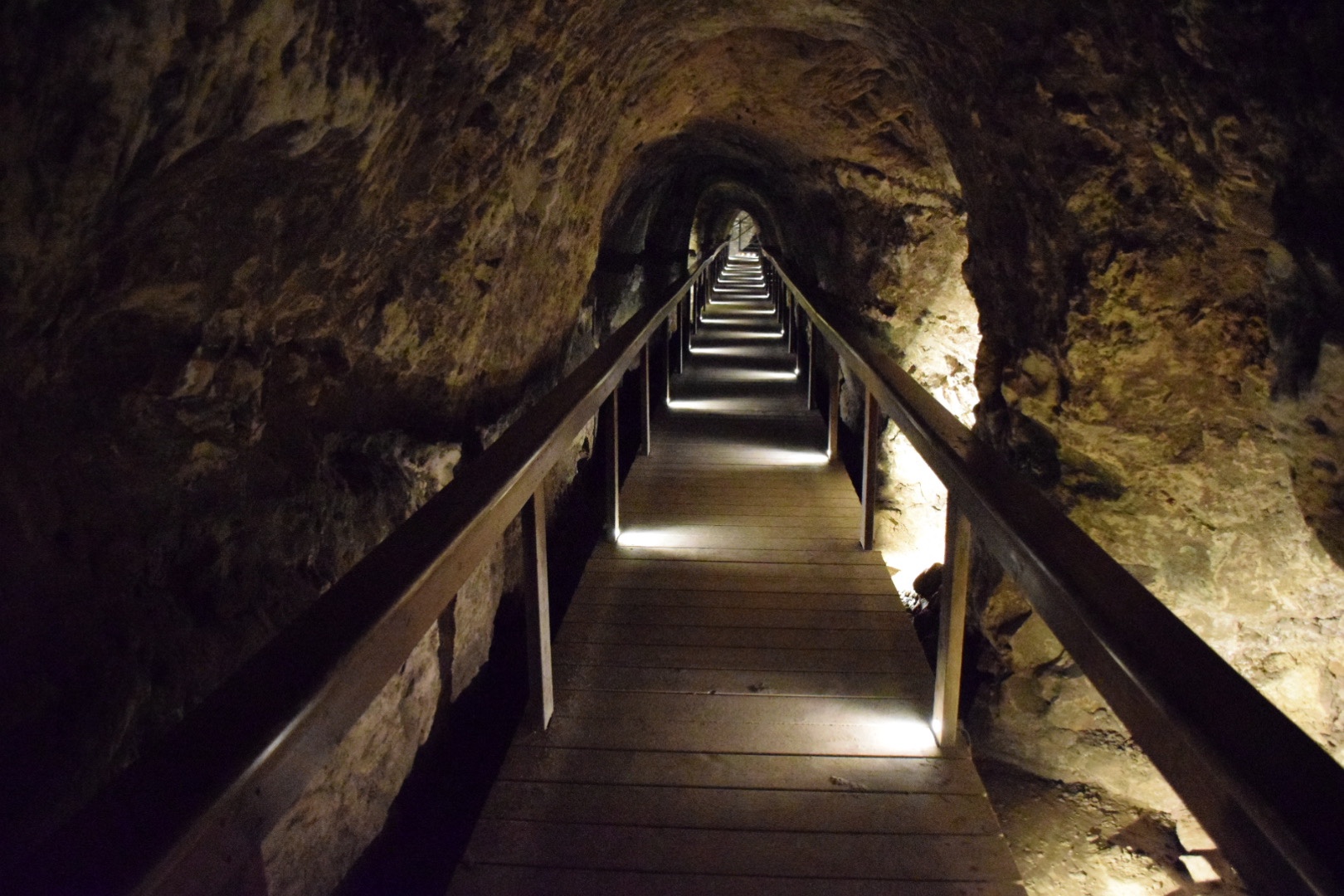
Some of us were able to climb down a lot of steps into the tunnel (we could see the remains of the original stairs on the way down), and then walk the length of the tunnel to the spring that is still there.
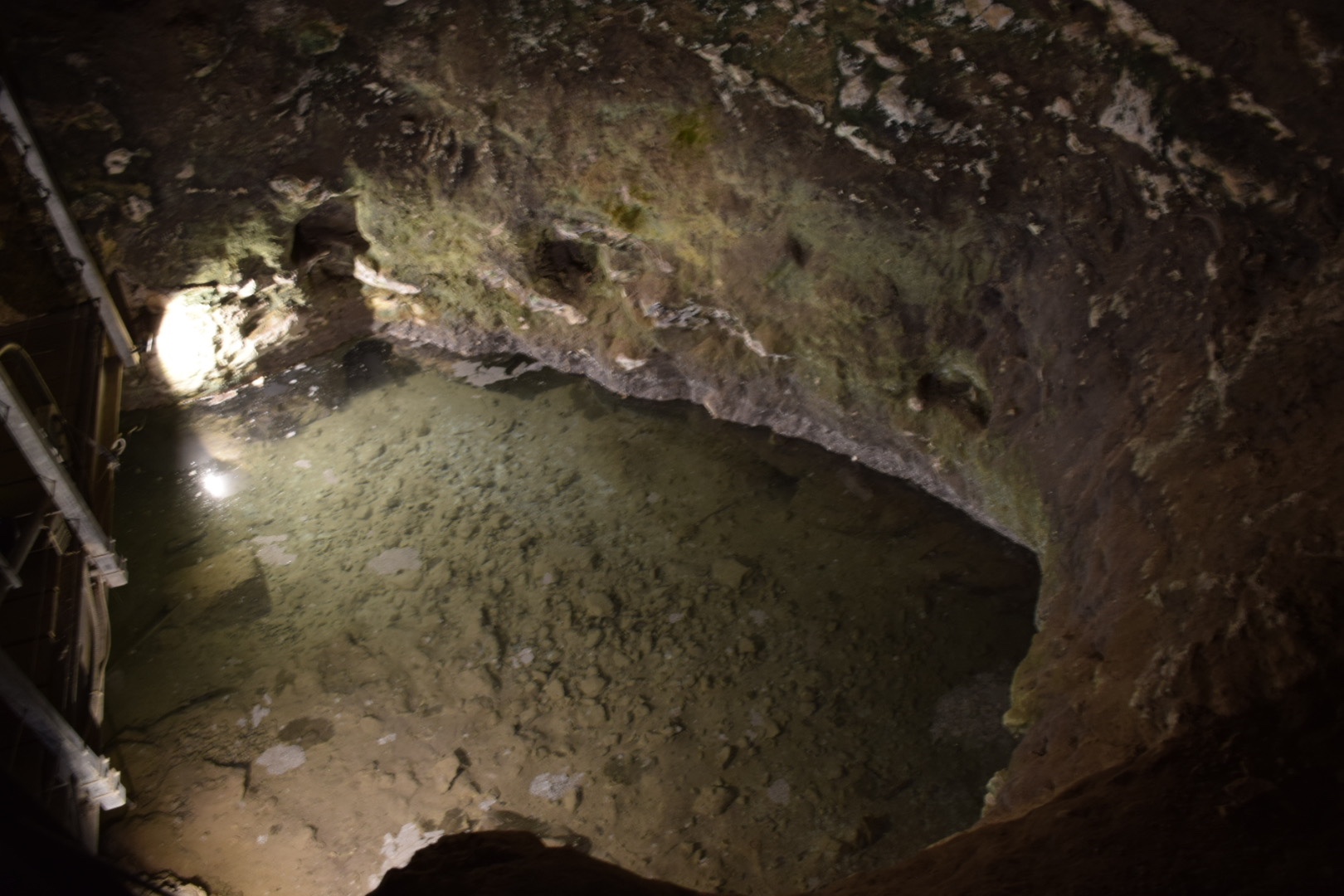
This was an awesome experience and was my favorite thing that we did all day. I can’t believe we got to walk through a tunnel built during the time of Ahab.
Before leaving Megiddo, we had an awesome buffet lunch back at the visitor’s center. I tried grilled chicken, rice, potatoes, and meat balls and enjoyed eating with Gary and Teresa Sartain, a couple from Hendersonville. Gary is also a hobbyist photographer, and he graciously took a number of pictures of me and my dad today at various sites.
Mt. Tabor
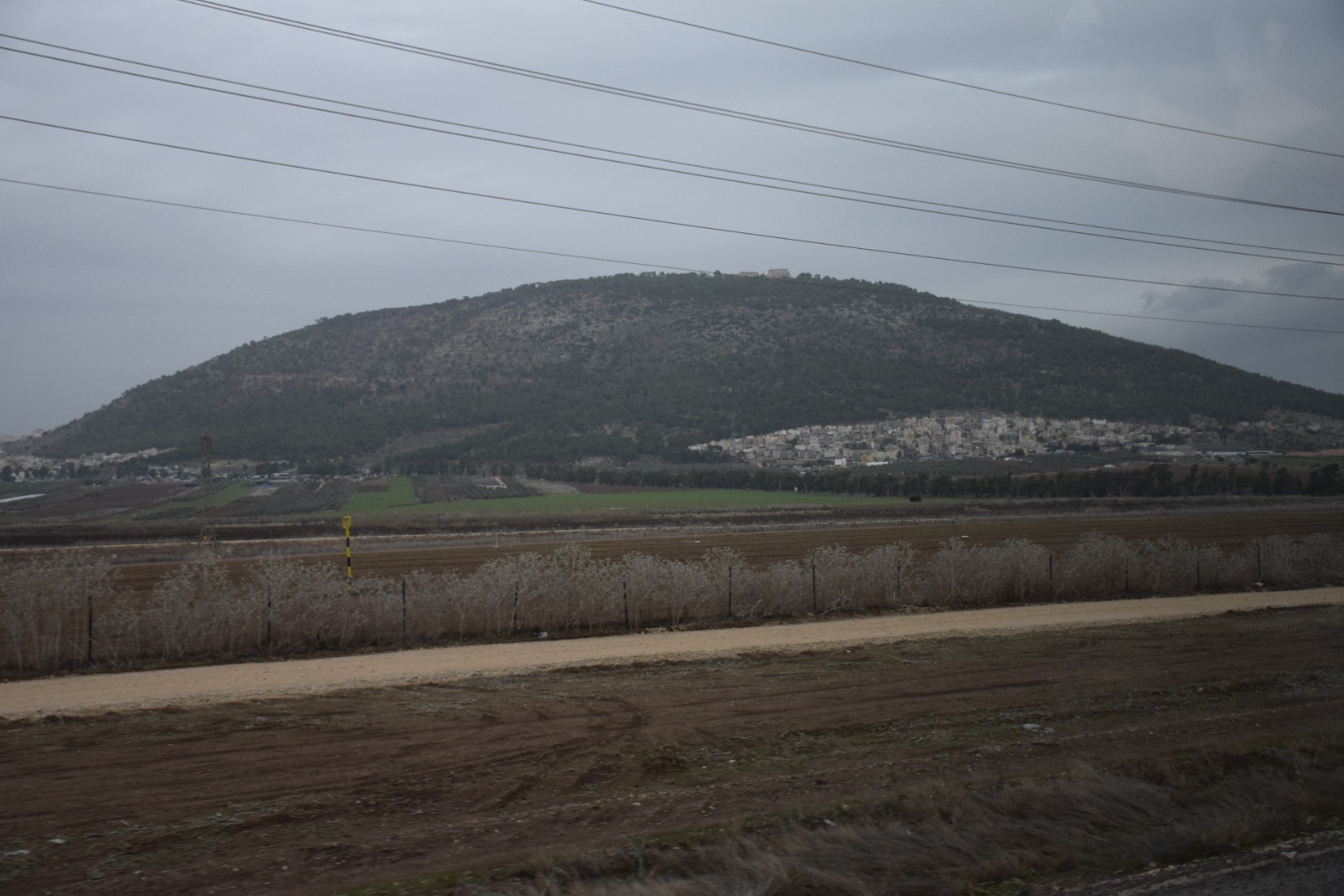
Our third stop was Mt. Tabor on the northwestern end of the Jezreel Valley. It is an isolated mountain that rises to 1,843 feet above sea level. It took us about 45 minutes to get to Tabor, and we are only able to take the busses part of the way up before boarding smaller vans to go the rest of the way up a very curvy road.
Tabor is mentioned in the Old Testament 11 times. Three of these are in Josh 19, where Joshua shows that the three tribal lands inherited by Zebulun (Josh 19:12), Issachar (Josh 19:22), and Naphtali (Josh 19:34) all border Mount Tabor. It also is the place where Deborah tells Barak of Yahweh’s command to gather an army (Judg 4:6, 12), and from which Barak descends (with his 10,000 men) to do battle against Sisera and his army (Judg 4:14).
Tabor is also mentioned in Judg 8:18 in a conversation between Gideon and two men he has captured in battle, where he asks, “What type were the men whom you killed at Tabor?” In 1 Chronicles 6:77, Tabor is mentioned as being allotted to the Merarites for its pastureland.
Even though Mount Tabor’s elevation was not that high, the psalmist compares it to the nearby Mount Hermon (Psa 89:12), and Jeremiah places it in parallel to Mount Carmel (Jer 46:18). Hosea uses the phrase “net spread out on Tabor” (Hos 5:1) to indicate God’s judgment on the idolatrous practices of the priests.
Mt. Tabor is never explicitly mentioned in the New Testament. However, since at least the fourth century AD, it has been suggested as the place of the transfiguration of Christ (Matt 17:1; Mark 9:2; Luke 9:28). Matt 17 simply says that they went to a “high mountain.” Some believe this could be Mt. Hermon in the Golan Heights, but Murad said that he really believes it was at Mt. Tabor (Dr. Cloud later said that he agreed). He believes it was at this site because it is the highest point in the Jezreel Valley (and that it is isolated), it has a rich Biblical history, and it functions as strategic or religious point in Israel.
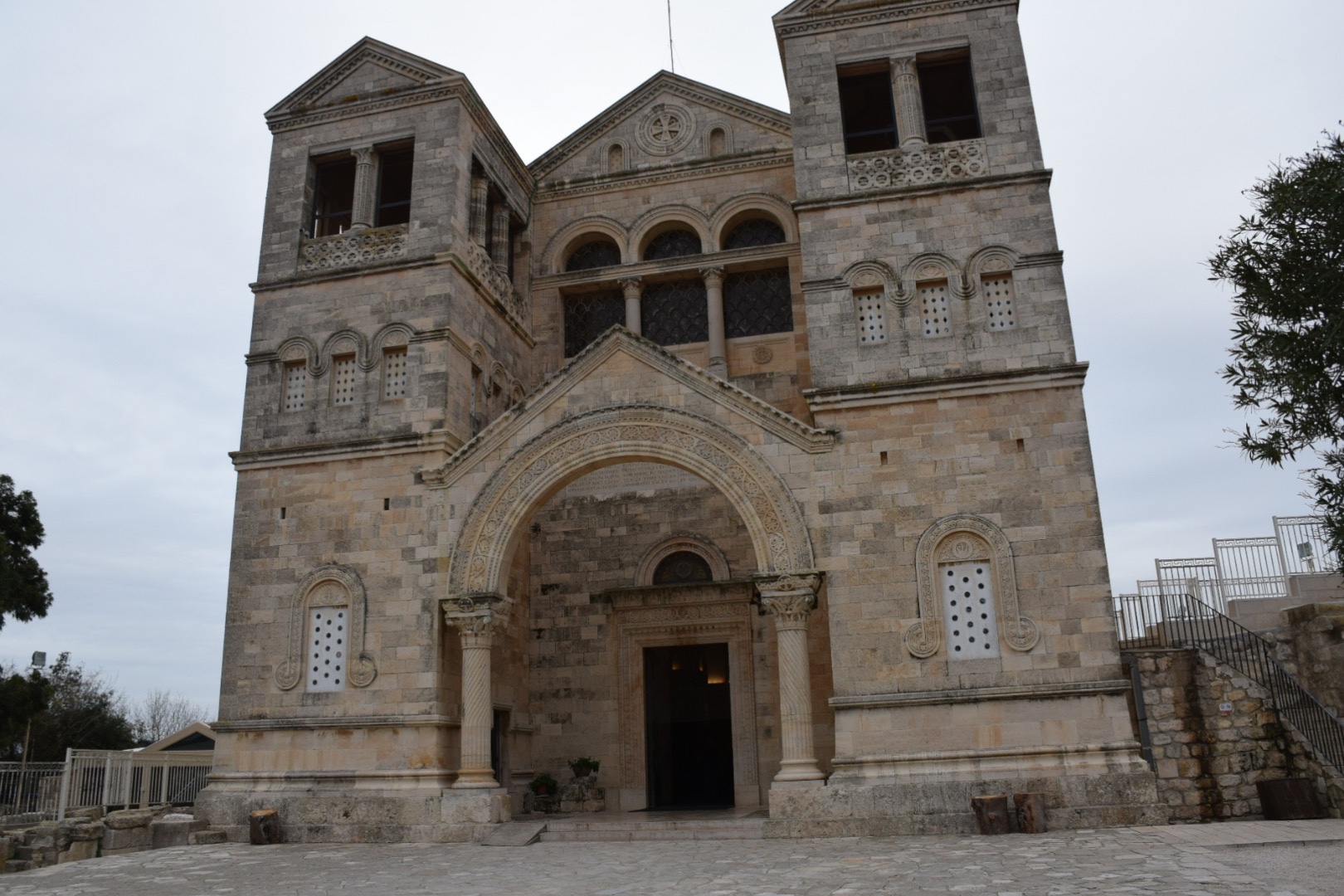
Up on top we saw a Catholic Church, and Murad explained that was built to represent the three tabernacles that Peter wanted to erect at the transfiguration.
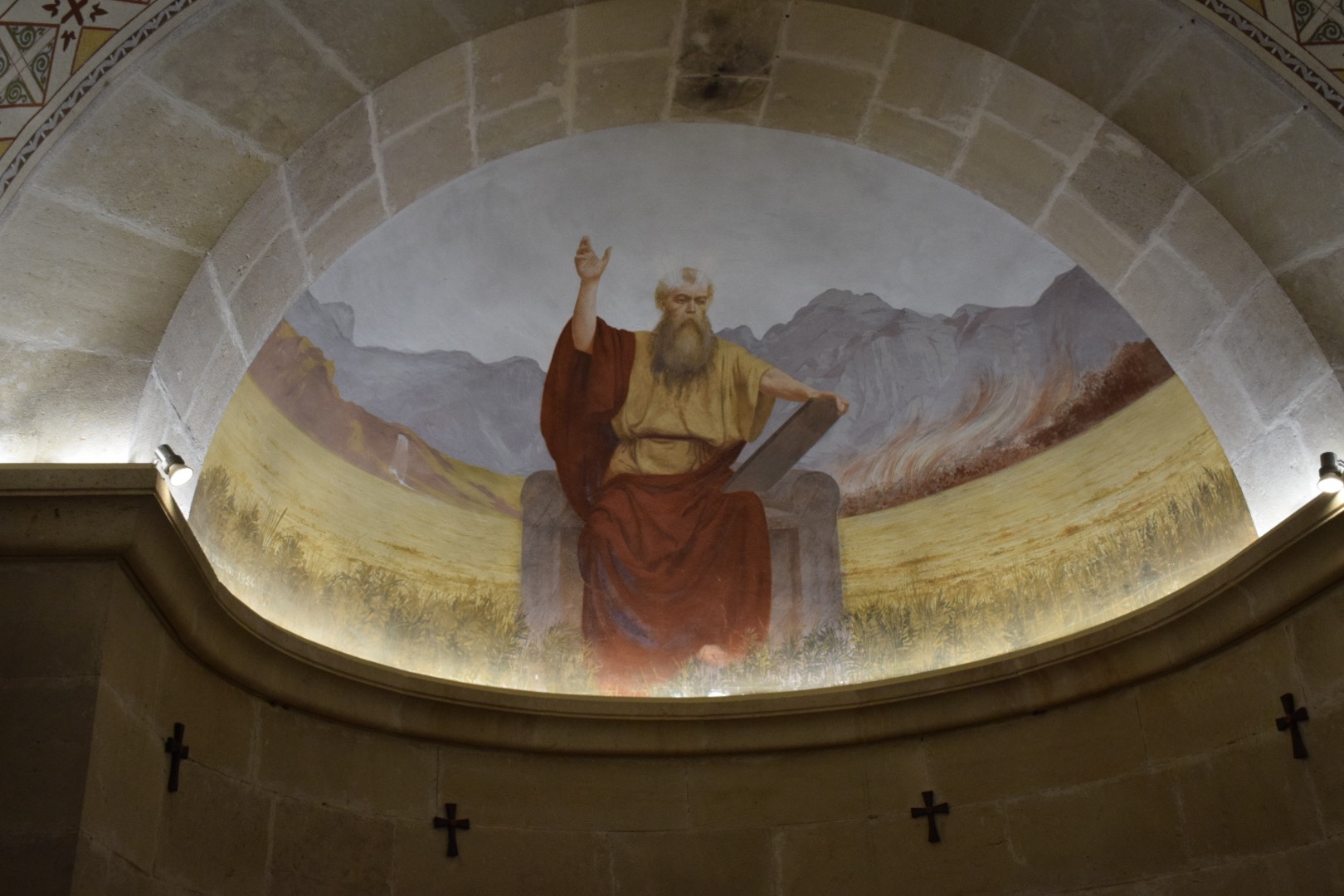
The section on the left is for Moses…
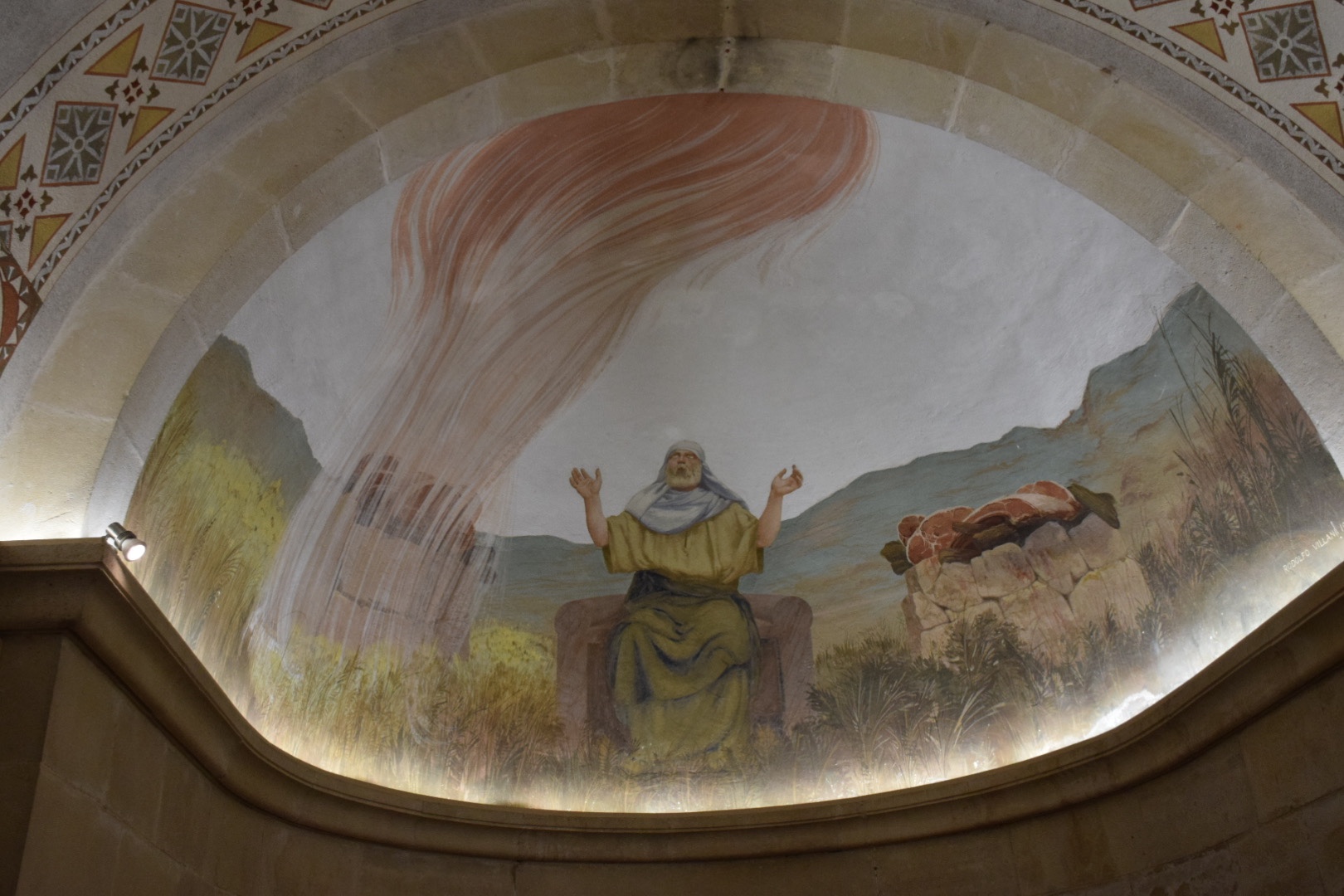
…the section on the right is for Elijah,
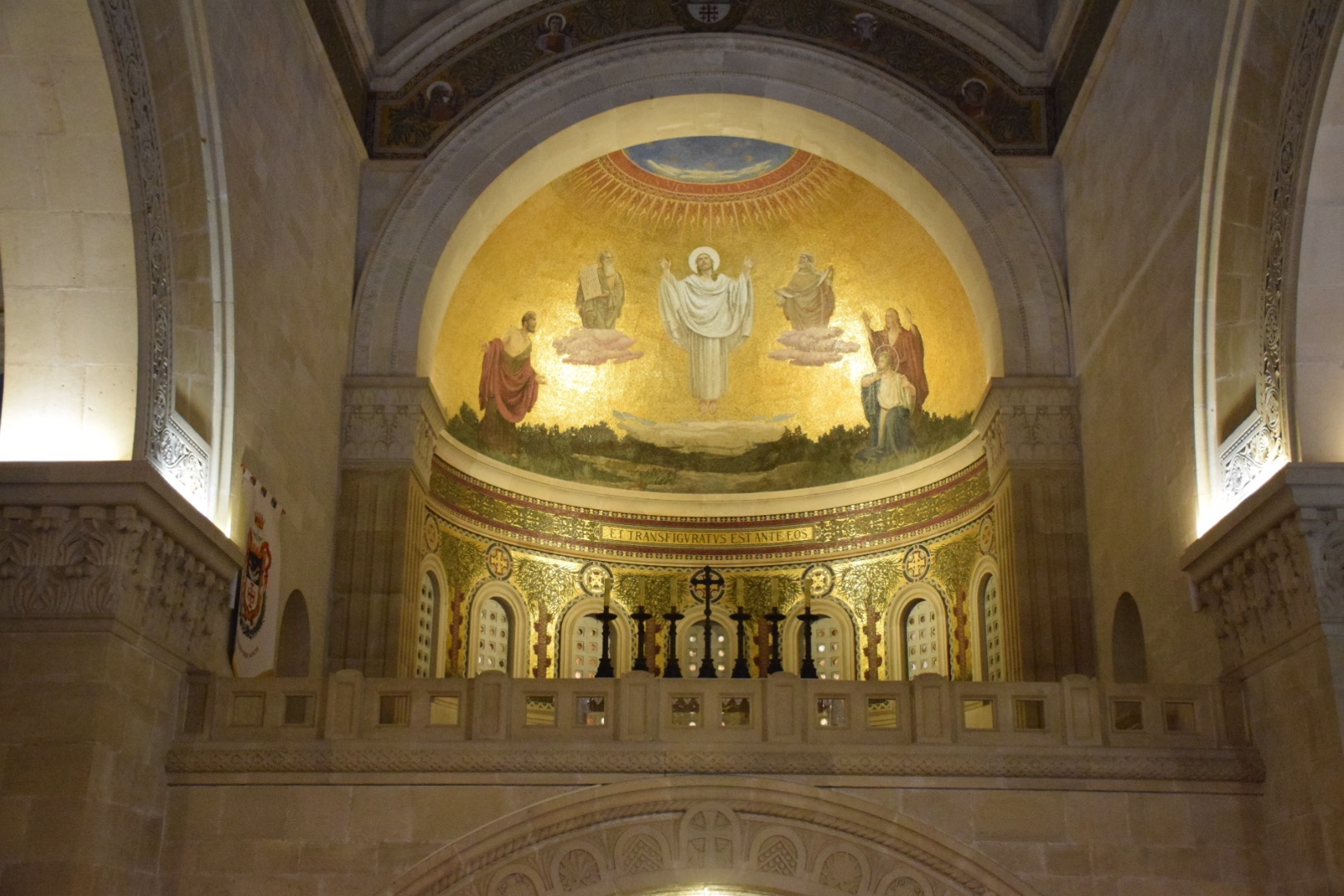
and the middle section is for Jesus and has two alters. The middle section also has a specific rock that is supposed to mark the specific spot of the transfiguration (it doesn’t).
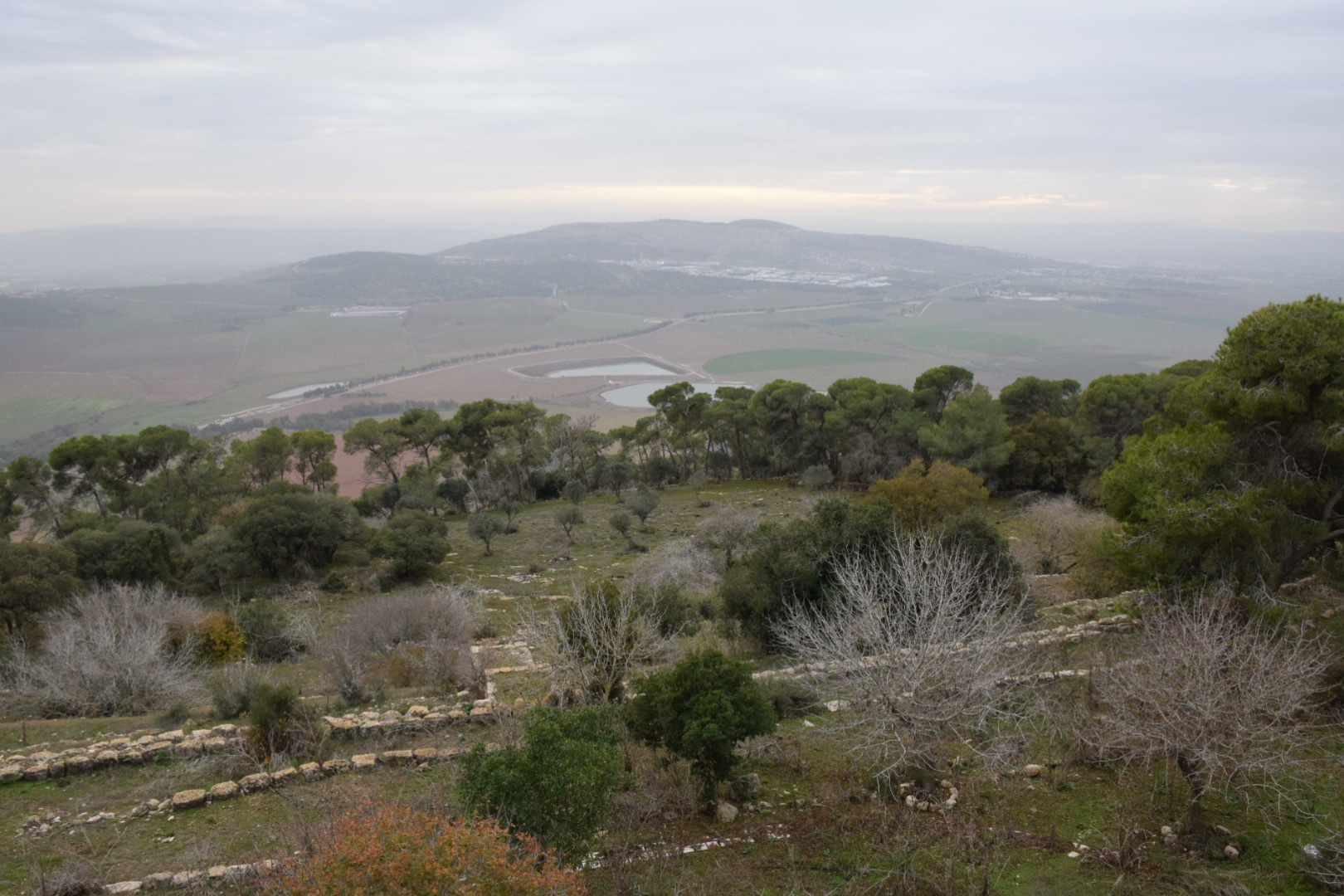
Outside we were able to enjoy some additional awesome views of the Jezreel Valley and Mt. Gilboa.
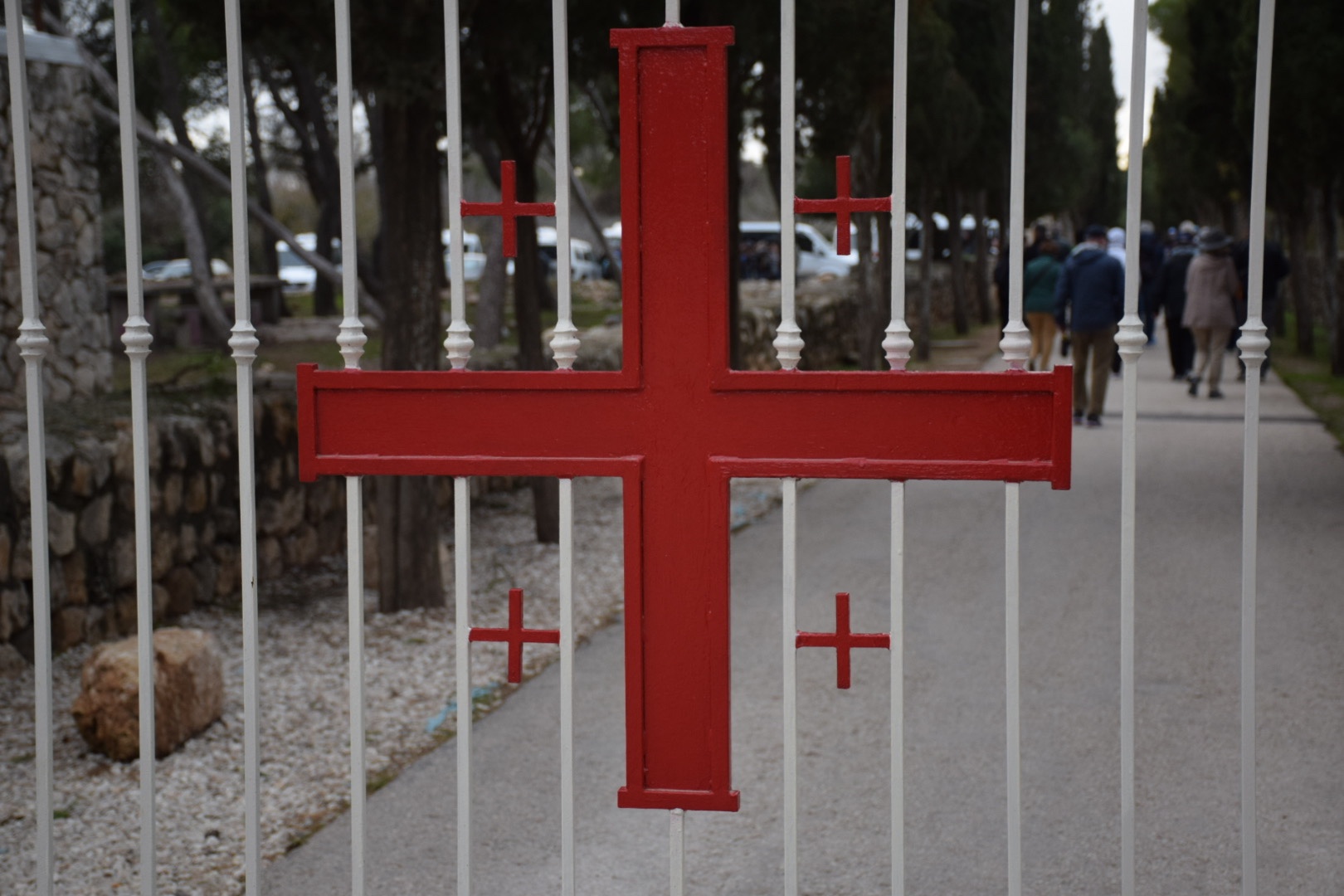
Before we left, Murad explained a flag that we could see with 1 big cross and 4 smaller crosses. This is now the flag of holy land. Some see it as representing the 5 wounds of Jesus or other see the large cross as Jerusalem and the small 4 are the four corners of the world.
Cana of Galilee
Our final stop was at the city of Kfar Kanna, which is one of two possible locations of Cana of Galilee. Cana of Galilee is mentioned in three passages of John’s Gospel:
*John 2:1–11 records Jesus’ first public miracle of turning water into wine at a wedding in the village of Cana.
*In John 4:46–54, Jesus was residing in Cana when He healed the royal official’s son who was in Capernaum—Jesus’ second public miracle that John records. The text repeats that Capernaum was “down” from Cana (John 4:47, 49, 51; see also John 2:12), suggesting that Cana was higher in elevation than Capernaum on the northern shore of the Sea of Galilee.
*John 21:2 cites Cana of Galilee as the hometown of Nathanael the disciple of Jesus. This may explain why Nathanael’s introduction to Jesus appears immediately before the wedding in Cana (see John 1:45–51).
As we walked around Murad said this was a good example of seeing a Jewish city as compared to a Roman city. Jewish cities were not planned out in advance and grew naturally. This resulted in buildings being expanded and roads being curvy or zig-zag to weave between them.
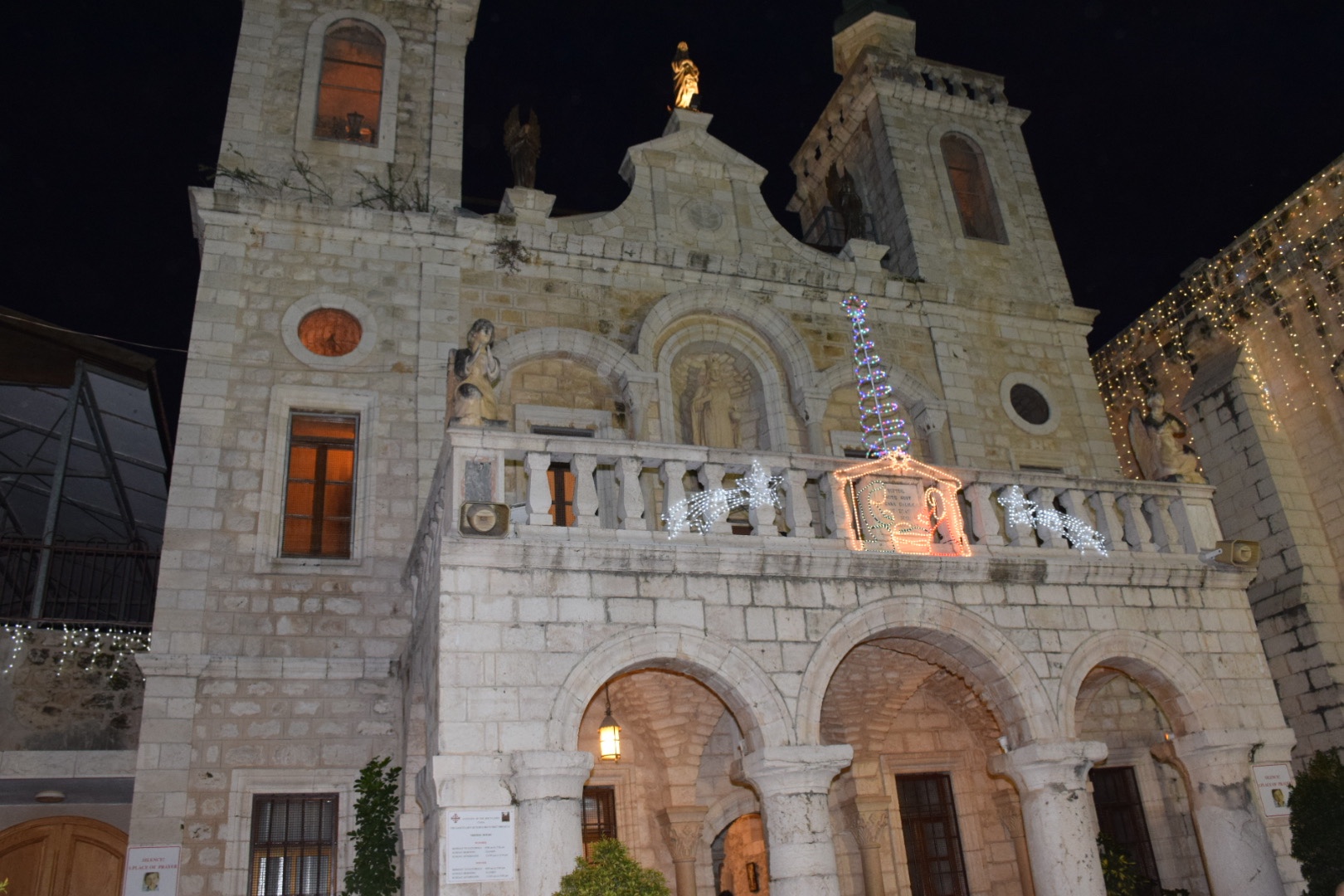
In Kfar Kanna we visited the Church of the Wedding briefly (this is a church that purports to be the location of the actual miracle) and then went to a neighboring store to see examples of old, large jars.
Tiberias
With another short drive (in the dark), we ended up at our hotel in Tiberias on the Sea of Galilee. Tiberias is one of the most important towns for the Jews and was built by Herod Antipas in 20 to 22 A.D. We checked in to the Leonardo Plaza Hotel and then I had a nice buffet dinner with my dad and Claudean.
After dinner we met at the Galilee room in the basement of the hotel for a presentation from Dr. Cloud about some of the sites today and preparation for the sites tomorrow. Jerry Barber also spoke briefly about shopping in Israel and Keith Parker spoke about scriptural references for the sites that we saw today. After the meeting I hung around with Dr. Cloud and Greg Tidwell to talk about Cana of Galilee and a number of other topics from the day.
I then walked down to the Sea of Galilee and called Olivia, Kate, and Sara back in the states (they are visiting the Creation Museum in Ohio today). We had a nice chat, and now I’m back in the hotel finishing up this post around 11:00pm, just before the start of the new year (not sure yet if I’m going to stay up or not). Tomorrow’s tour is supposed to include Tel-Hazor, Tel-Dan, and Caesarea Philippi.

I love following your trip. I can’t wait to hear the stories you’ll share in bible class. May God continue to keep you all safe and bless this unforgettable trip.
BTW, I liked Murad’s joke about why Peter denied Jesus three times. It might be true, you know?